The Complete History of the TAG Heuer Monaco Chronograph
Looking back at a legendary chronograph that had not always been loved…

Few chronographs capture the spirit of their era as vividly as the Heuer Monaco. Born at the crossroads of watchmaking tradition and a rapidly changing world, it arrived in 1969 with angles as sharp as the decade itself. Following our article covering the story of the Heuer Carrera Chronograph, we now look at the history of the Monaco Chronograph, which continues to be written.
A Decade in Acceleration, from Classic Lines to Radical Angles
The Heuer Carrera, launched in 1963, distilled decades of timing expertise into a watch that was clean, legible, and purpose-built for the track. It became the archetype: restrained, elegant, and timeless. But the world around it was changing at a dizzying pace.
The late 1960s were marked by acceleration in every sense. Technology put men on the Moon in 1969, while on the ground, Formula 1 cars became faster, louder, and even more dangerous with each passing season. Architecture became sharp and geometric; pop art splashed colour across galleries and billboards; and car designers imagined radical wedges that seemed drawn from science fiction. Watches, by contrast, remained rooted in conservative traditions. Most chronographs were still round, their designs carried over from the 1950s.
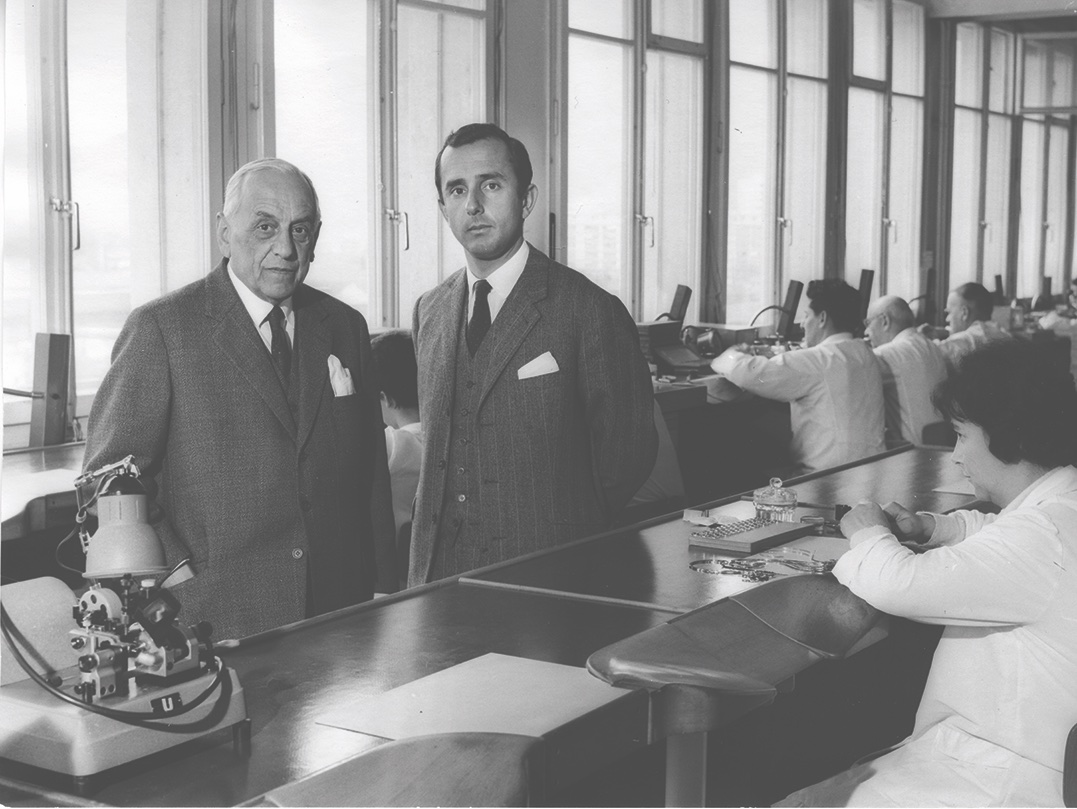
If the Carrera represented clarity and tradition, the next Heuer chapter needed to capture the daring spirit of the new decade. The chronograph had to evolve, not just mechanically, with the long-awaited move to automatic winding, but visually as well. It needed to look modern, bold, and unmistakably different.
In 1969, Heuer unveiled that answer. Alongside the Carrera and Autavia, the brand launched a square-cased, water-resistant chronograph with a vivid blue dial and a design that seemed to come straight out of the future. This was the Monaco, a watch that stood in deliberate contrast to the Carrera, as much a symbol of design rebellion as it was a technical achievement.
1969–1974 – The Vintage Monaco Models
1969 – The Birth of a Square Icon
On 3 March 1969, Heuer unveiled the Monaco reference 1133, as part of the orchestrated launch of the Calibre 11 automatic chronograph. Calibre 11 was the result of Project 99, the joint venture with Breitling, Büren, and Dubois Dépraz that produced the self-winding chronograph, introduced just months after the Zenith El Primero.
The breakthrough came from Piquerez (EPSA), Heuer’s long-standing case supplier, also known for the compressor cases. EPSA had developed the square case that could be made fully water-resistant. As Jack Heuer later wrote in his Autobiography, the company immediately saw the potential. Until then, square cases were confined to delicate dress watches, since they could not be properly sealed. Heuer secured exclusive rights for chronograph use, ensuring competitors like Breitling could not adopt it for their own. This futuristic case would provide the perfect frame for the avant-garde Monaco, a model intended to showcase the daring new movement.
At 39mm, with sharp angles, a mix of brushed and polished surfaces, and a left-hand crown to indicate that winding was no longer of importance, the Monaco was unlike anything else at Basel in 1969. The earliest executions, the 1133B “Chronomatic”, carried a metallic sunburst blue dial with square-ended steel hands and the word “Chronomatic” above the Heuer shield. Confusion over the term, particularly in the U.S., led the company to abandon it almost immediately. Transitional pieces followed, before settling on the more familiar production Monacos: the 1133B in matte blue with white registers, and the 1133G in grey, first with tone-on-tone subdials and later with striking black contrasts.
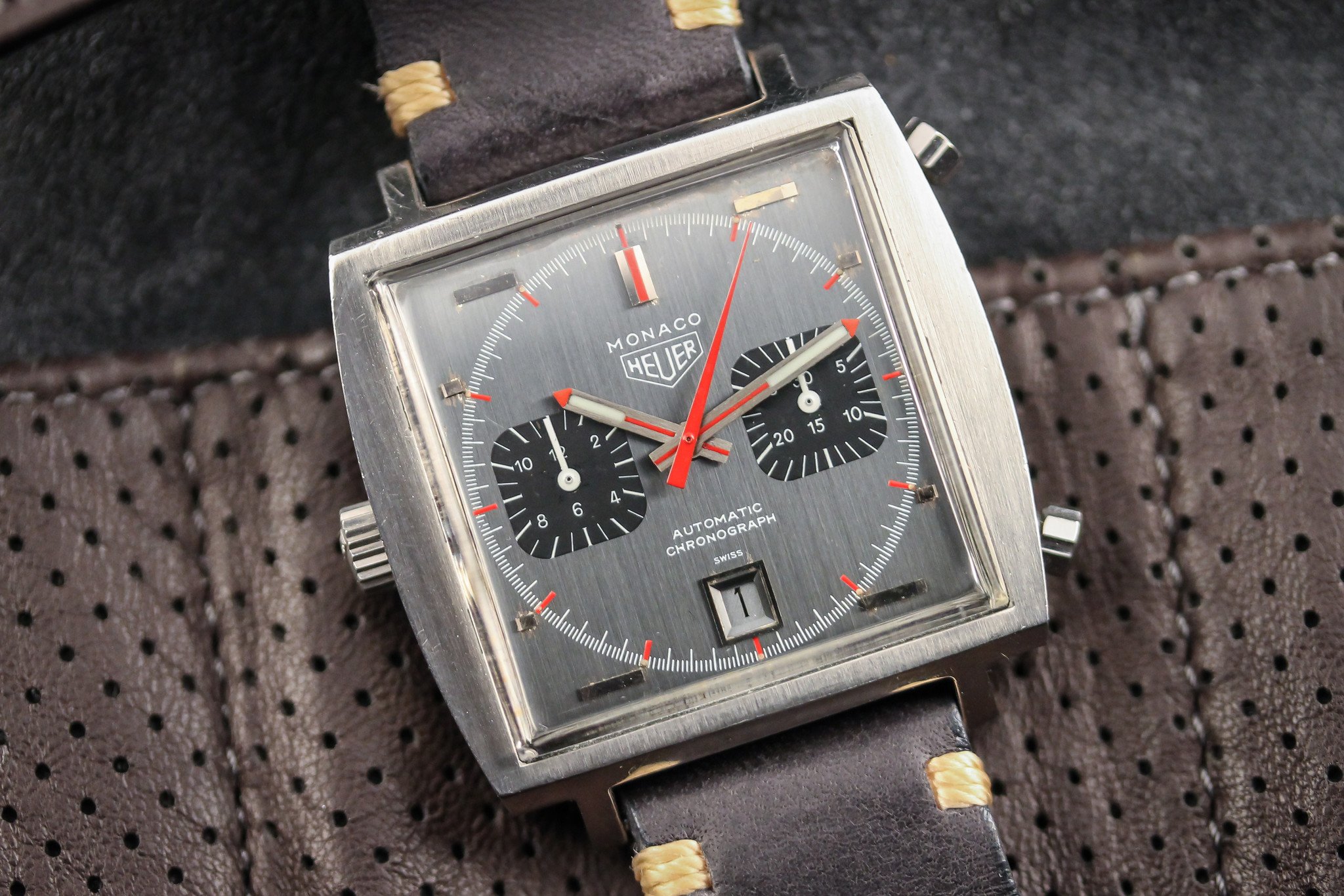
1970 – Steve McQueen and “Le Mans”
The Monaco’s legend, in great part, was cemented not in the showroom but on the silver screen. In 1970, property master Don Nunley contacted Heuer to supply stopwatches, chronographs, and other timing gear for a new racing film starring Steve McQueen. Jack Heuer recalled in his memoir how the company rushed equipment to the set at Le Mans, even resorting to less-than-official methods to speed the delivery, entrusting the “smuggling” caper to Gerd-Rüdiger Lang, future Chronoswiss founder and an important figure in the 1990s mechanical renaissance, who “had asked to work for us to improve his knowledge of watchmaking in general and chronographs in particular”.
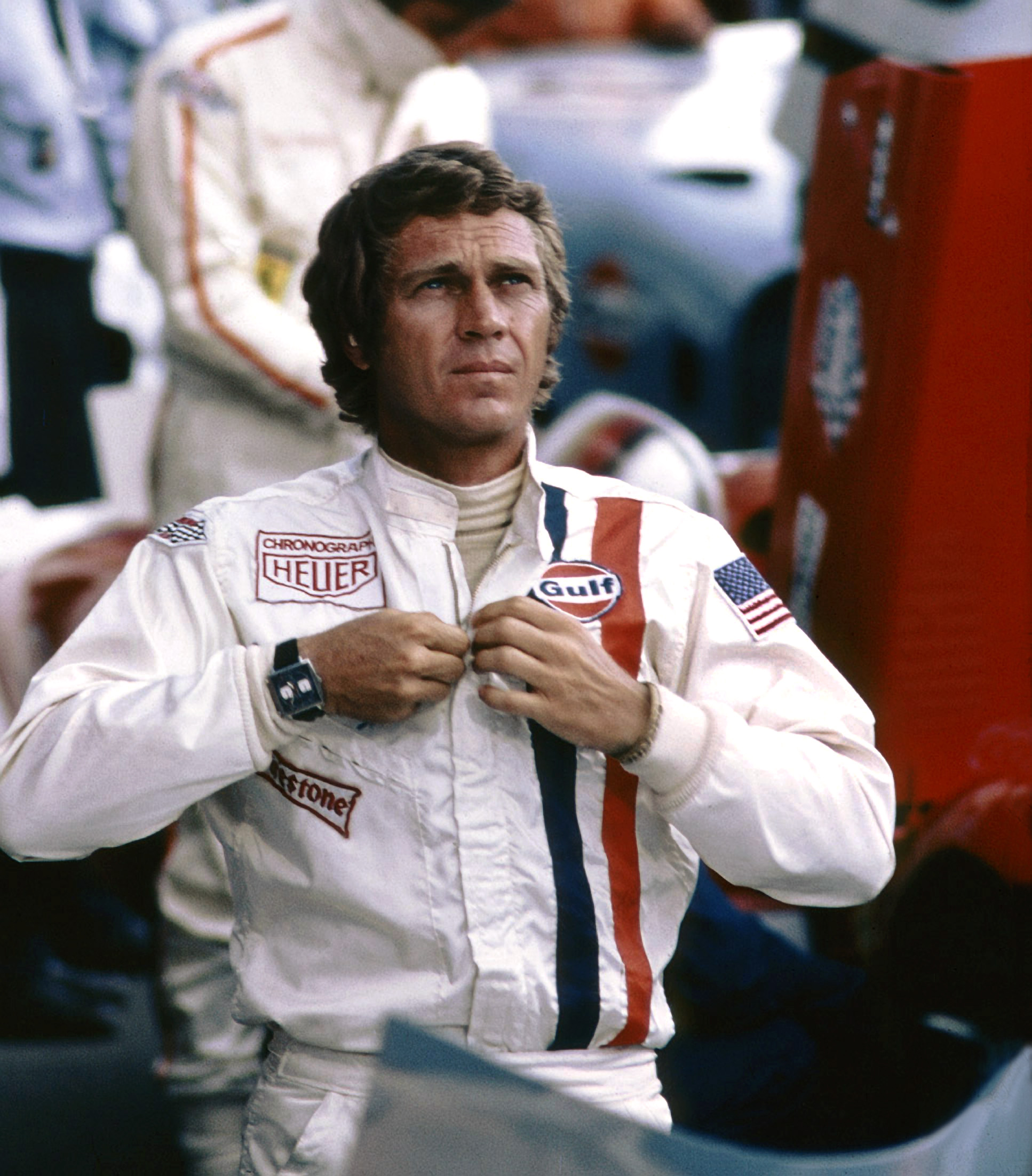

McQueen, already working closely with drivers Jo Siffert and Derek Bell to master the Porsche 917 for the film, chose to model his character on Siffert’s professional image. Siffert’s white overalls bore a Heuer logo, and continuity required that the watch match. The Monaco was chosen because it was one of the few models Nunley had in triplicate for filming. When Le Mans premiered in 1971, the film struggled commercially, but McQueen’s image wearing the blue-dial 1133B on his wrist endured. Over time, this “McQueen Monaco” became one of the most recognisable chronographs in watch history.
1972 – Expanding the Family, Calibre 15 and hand-wound Variants
By 1972, Heuer expanded the Monaco line to include cost-reduced and manual-wind versions. The reference 1533B introduced the Calibre 15, a simplified version of the Calibre 12 that omitted the hour recorder and featured a new register layout. Its asymmetry, with a 30-minute counter at 3 o’clock and small running seconds squeezed between 9 and 10 o’clock, gave the dial a distinctive character. Applied hour markers were arranged radially, further setting it apart. A grey-dial variant, the 1533G, featured a brushed metallic finish with a deep blue-grey chronograph minutes subdial.
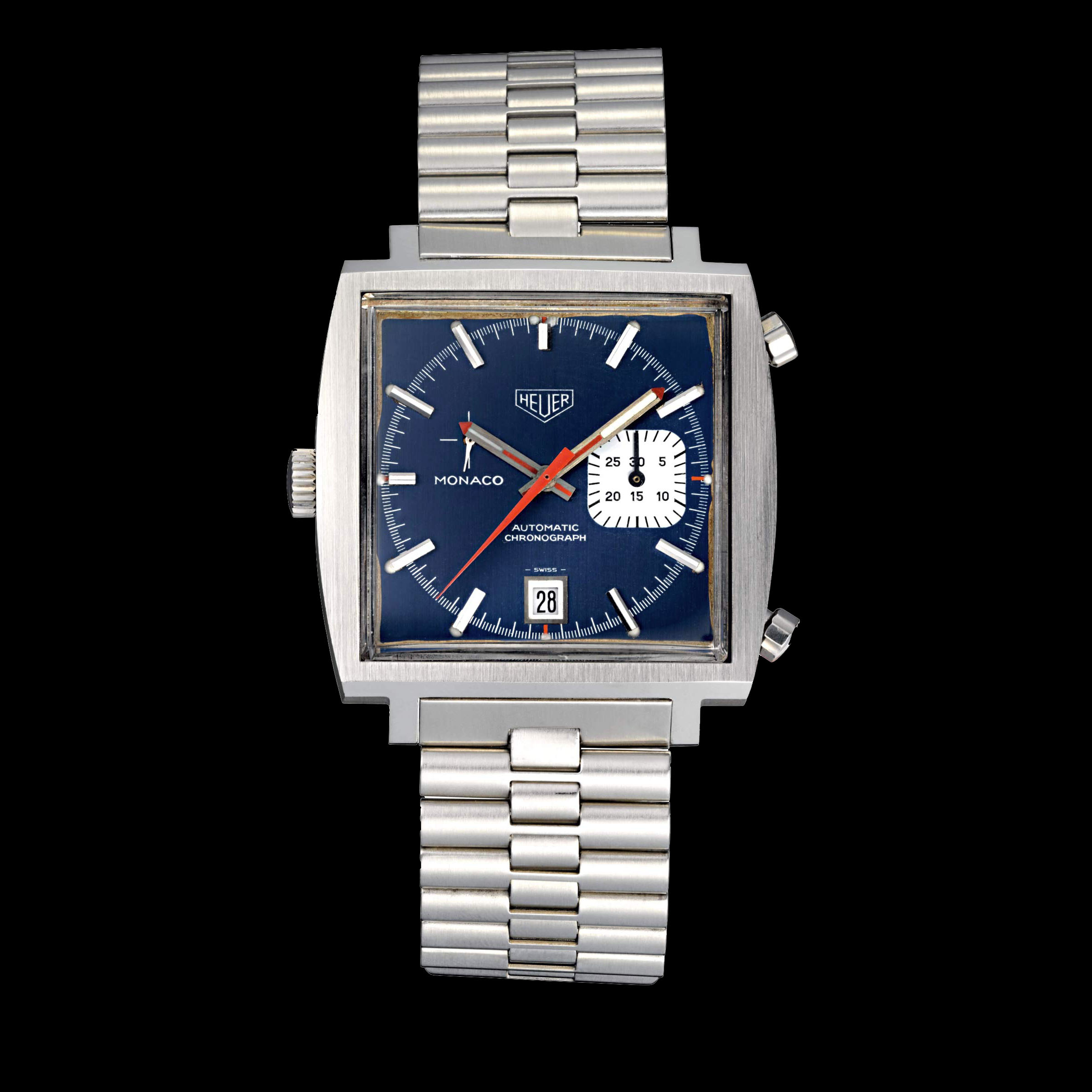
At the same time, manual-wind Monacos appeared, powered by the Valjoux 7736, with the crown on the right side of the case. The 73633B mirrored the McQueen’s blue-and-white aesthetic but added a running seconds at 9 o’clock, while the 73633G was offered in two executions: first with grey registers matching the dial, then with contrasting black subdials. These watches broadened the Monaco’s reach while maintaining the case and overall design language.
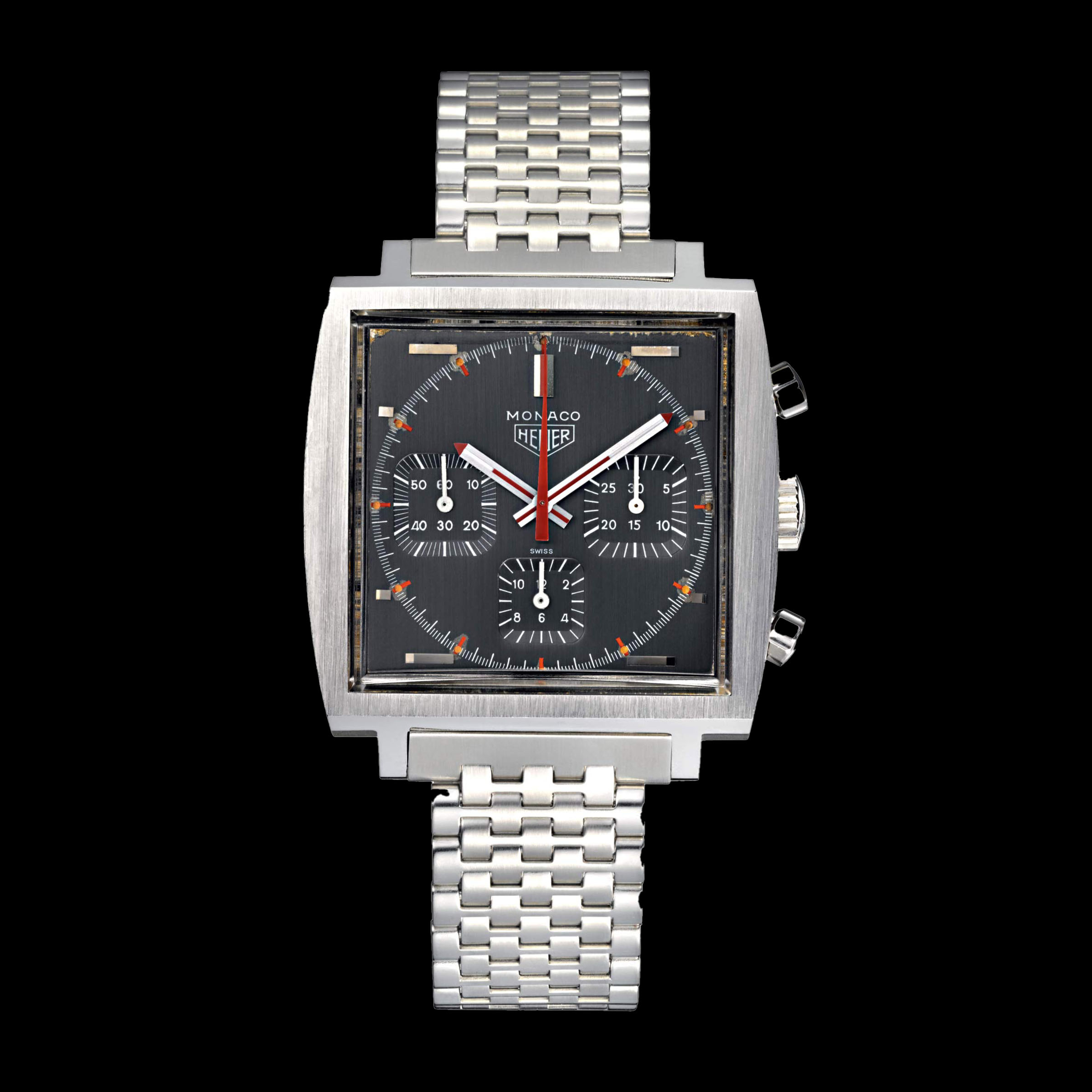
1974 – The Dark Lord… The Monaco Goes Black, and Disappears
Despite the publicity brought by Steve McQueen’s appearance in Le Mans a few years earlier, the model never really resonated with the broader public, and by 1974, the Monaco was struggling. Its square case, radical geometry, and futuristic blue dial were simply too unusual for conservative buyers who still wanted a chronograph to be round. While creative minds such as Stanley Kubrick or Sammy Davis Jr. could appreciate its avant-garde charm, most consumers left it sitting in display cases. The Monaco quietly disappeared from Heuer’s catalogue that year, replaced by the softer, more approachable, rounded Silverstone.
But that wasn’t quite the end of the story. By the late 1970s, as the quartz crisis bit deep into Switzerland, Heuer found modest success experimenting with black-coated cases. Models like the Monza, launched in 1976 to celebrate Niki Lauda’s Formula 1 championship, embraced a stealthy black chromium oxide finish that also spread to Carreras and Montreals. The aesthetic tapped into the military-inspired mood of the time, an echo of Vietnam-era field gear and tactical design and gave Heuer’s chronographs a new edge.
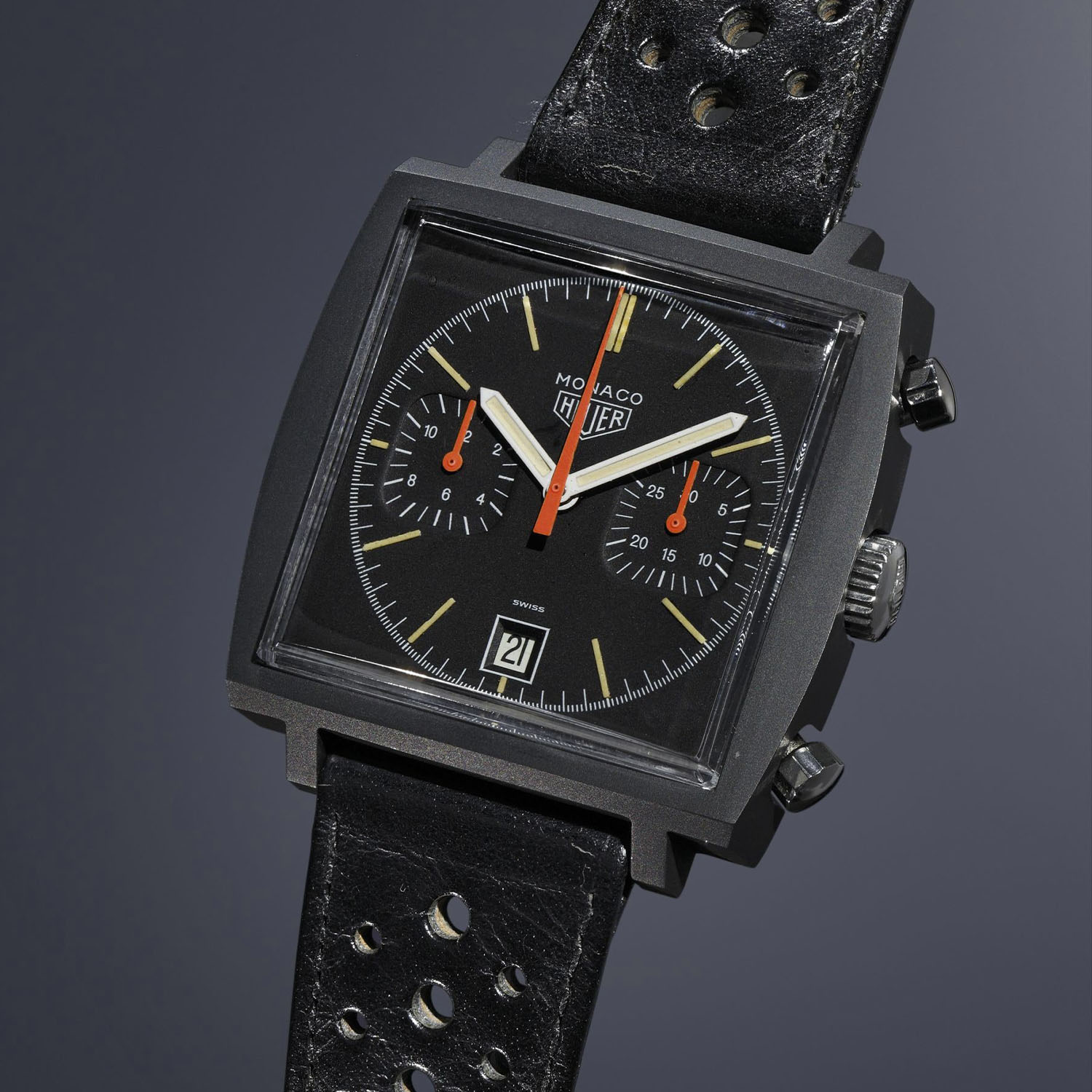
It was against this backdrop that a small batch of Monaco cases, left over from earlier production, found a second life. Destined to be reference 74033 Monacos with stainless steel cases and blue dials, these cases were instead coated in black. Heuer’s dial maker, Singer, supplied simplified dials: flat, matte black, stripped of applied markers, paired with bold orange accents on the chronograph hands and lume strips. A Valjoux 7740 manual-wind calibre, two registers, date at six, was fitted inside the experimental case. The result was stark, industrial, and almost shockingly modern.
Never officially included in a catalogue, these blackened Monaco watches (Ref. 74033N) were likely distributed in minimal numbers across select markets in Europe and the Americas between 1977 and 1978. Collectors later nicknamed them the “Dark Lord”, a fitting title for a watch that seemed to absorb light rather than reflect it. Its sharp angles, matte surfaces, and bursts of orange gave it a presence unlike anything else of the time. In many ways, it anticipated the all-black trend that would sweep high-end watchmaking nearly three decades later.
At the time, the decision was pragmatic. Black-coating the case eliminated the need for complex brushing and polishing, while the simplified dials kept costs lower. The idea was to test whether a stripped-down Monaco, presented in this new stealth aesthetic, could find an audience. Ironically, what was then a cost-saving exercise has become one of the most collectable vintage Heuers of all, with only a few hundred produced, and even fewer surviving in good condition.
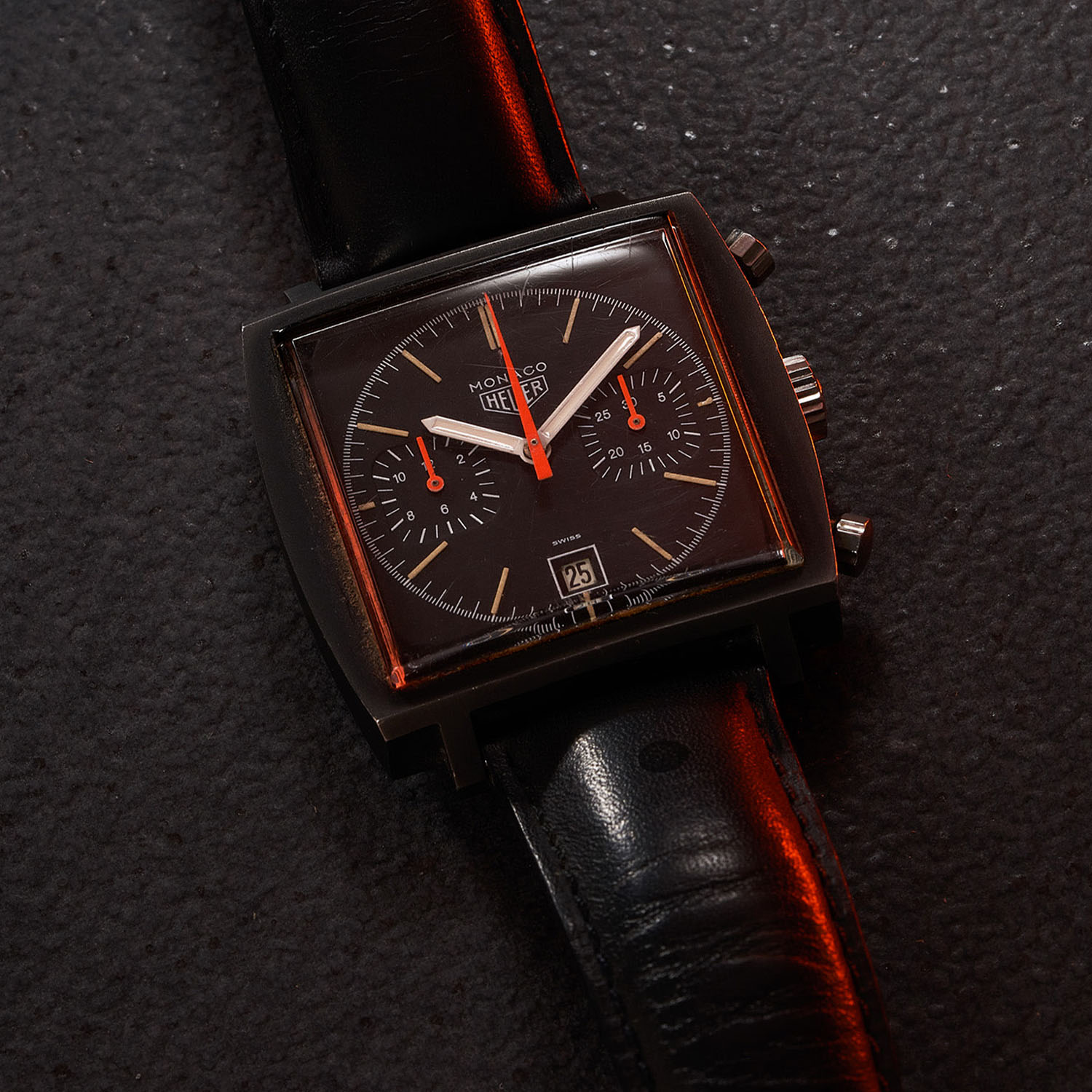
Beyond rarity, what makes the Dark Lord so compelling is its vision. It distilled the Monaco down to a brutalist essence: black on black, broken only by flashes of orange. Minimalist yet dramatic, it achieved the same clarity that Jack Heuer had pursued with the Carrera a decade earlier, but with a futuristic edge, and as we shall see, its DNA would later echo across the Monaco line. What began as an experiment in the late 1970s has evolved into one of the most enduring stylistic legacies of the Monaco.
1997-2009 – The Revival
1997 – A New Square for a New Era
When TAG Heuer resurrected the Monaco in 1997, it marked the return of one of the most distinctive shapes in watchmaking. The reference CS2110, a 5,000-piece limited edition, was not a carbon copy of the 1133B but a modern reinterpretation. Its 38mm stainless steel case appeared square, though with more regular, even proportions than the original’s slightly over-square, curved-edge form. The case was also thicker, built to modern standards of durability, with a 30m water-resistance.
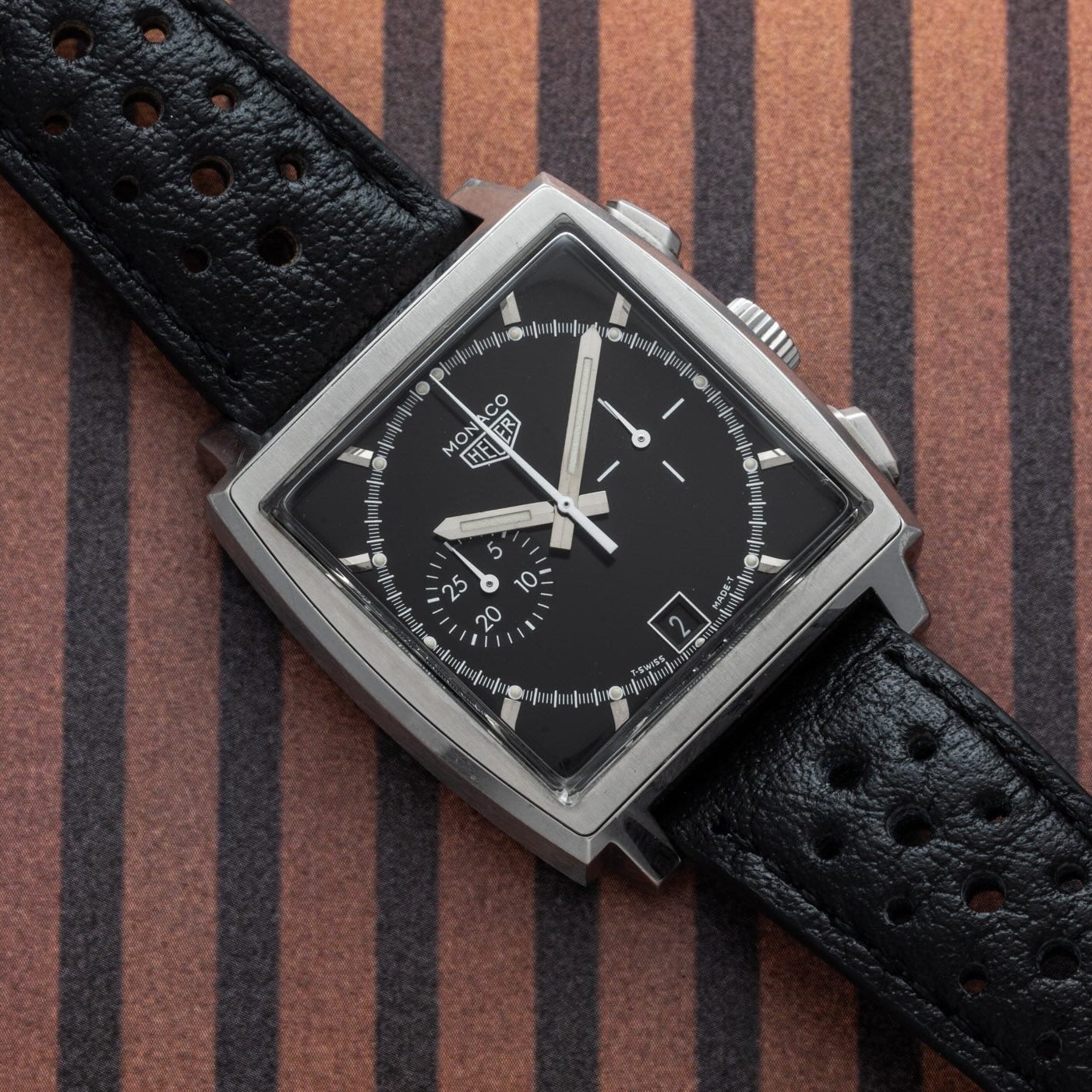
Inside was a modular automatic chronograph calibre with a Dubois-Dépraz chronograph module on top of the ETA 2894-2 base. Beating at 28,800 vibrations/hour, it offered a 42-hour power reserve and a reliable cam-lever chronograph system, a far cry from the quirky modular Calibre 11 of 1969, but a strong modern alternative. The dial was matte black with cross-haired running seconds at 3 o’clock, a detail borrowed from 1970s Calibre 15 Monacos. Sapphire crystal replaced acrylic.
For TAG Heuer, this was a cautious release. The Monaco had once failed commercially, disappearing after only a few years in the 1970s. But consumer tastes had changed, and by the late 1990s, its bold square design resonated with clients in Italy, continental Europe, and North America.
1998-2003 – Blue Returns, and Heritage Settles In
Next, the brand presented another Monaco “re-edition”, the CS2111, with an all-black dial featuring three subdials, with a 12-hour counter and radial applied markers. In 2001, the CS2113 followed, a silver-dial limited edition powered by the same ETA 2894-2. The success of the CS2111 led to further expansion; the model was added to the permanent collection, now designated as CW2111 and bearing a TAG Heuer logo, and not the old Heuer.
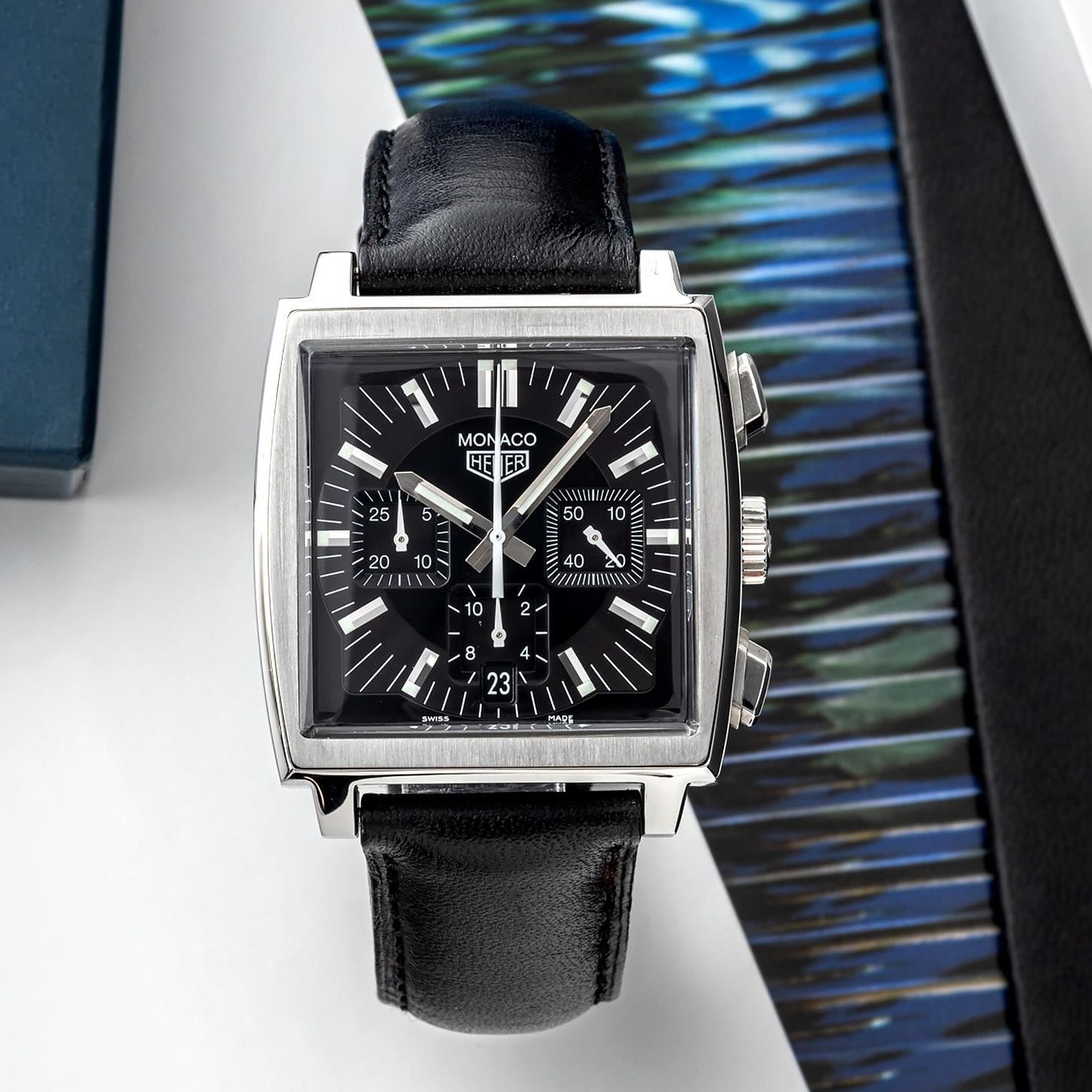
By 2002-2003, TAG Heuer pushed the Monaco re-edition further with reference CW2113, a watch that leaned unapologetically on the look of the original 1133B worn by Steve McQueen in Le Mans: rich blue dial, white sub-registers, square 38mm case, and bold red chronograph hands. No longer just a nostalgic, limited-edition experiment, the Monaco was now firmly cemented as a pillar of TAG Heuer’s catalogue. The faithful design cues signalled that the Monaco had truly returned, not as a retro curiosity, but as a modern classic.
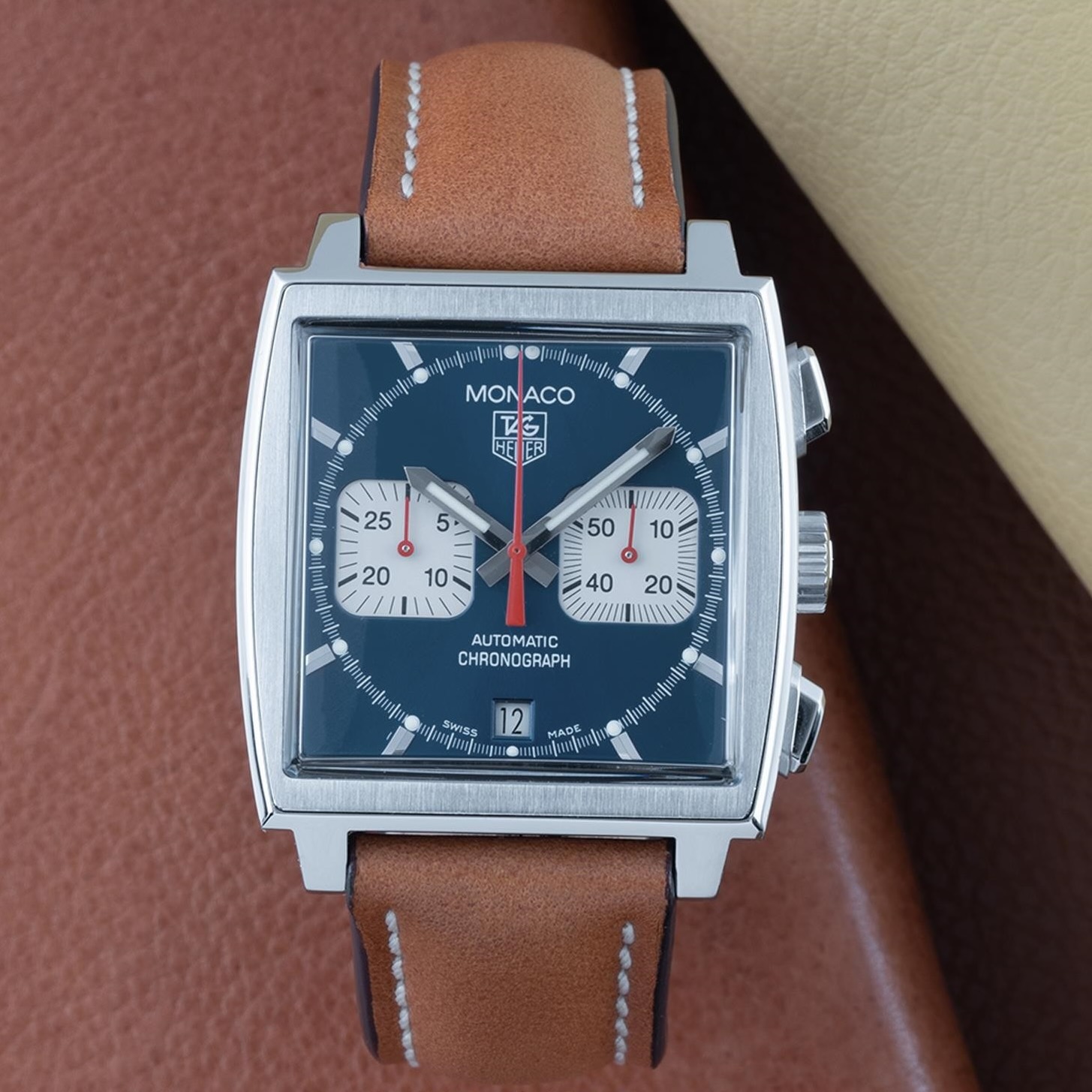
2005 – The Monaco Sixty-Nine and the Gulf Edition
In 2005, TAG Heuer seemingly tested just how far the Monaco could stretch. The CW9110 “Monaco Sixty-Nine” featured a reversible case, where one side housed a manually wound ETA 7001 mechanical movement with running seconds at 6 o’clock, and the other hosted a digital quartz module with chronograph and alarm functions. An ultimate Janus watch, symbolising TAG Heuer’s dual legacy in mechanical and quartz timekeeping.
Another 2005 release was the CW2118, the first Monaco to bear the Gulf Oil racing stripes. The light blue and orange livery of John Wyer Racing had become a motorsport icon in the late 1960s, immortalised by Steve McQueen’s Le Mans film and the Porsche 917. The Gulf Monaco brought this visual identity to the dial, with vertical stripes running down the left side and orange chronograph hands adding contrast. Powered again by the ETA 2894 base movement, this edition became an instant collectable and kicked off a series of Gulf-themed Monacos that continue to this day.
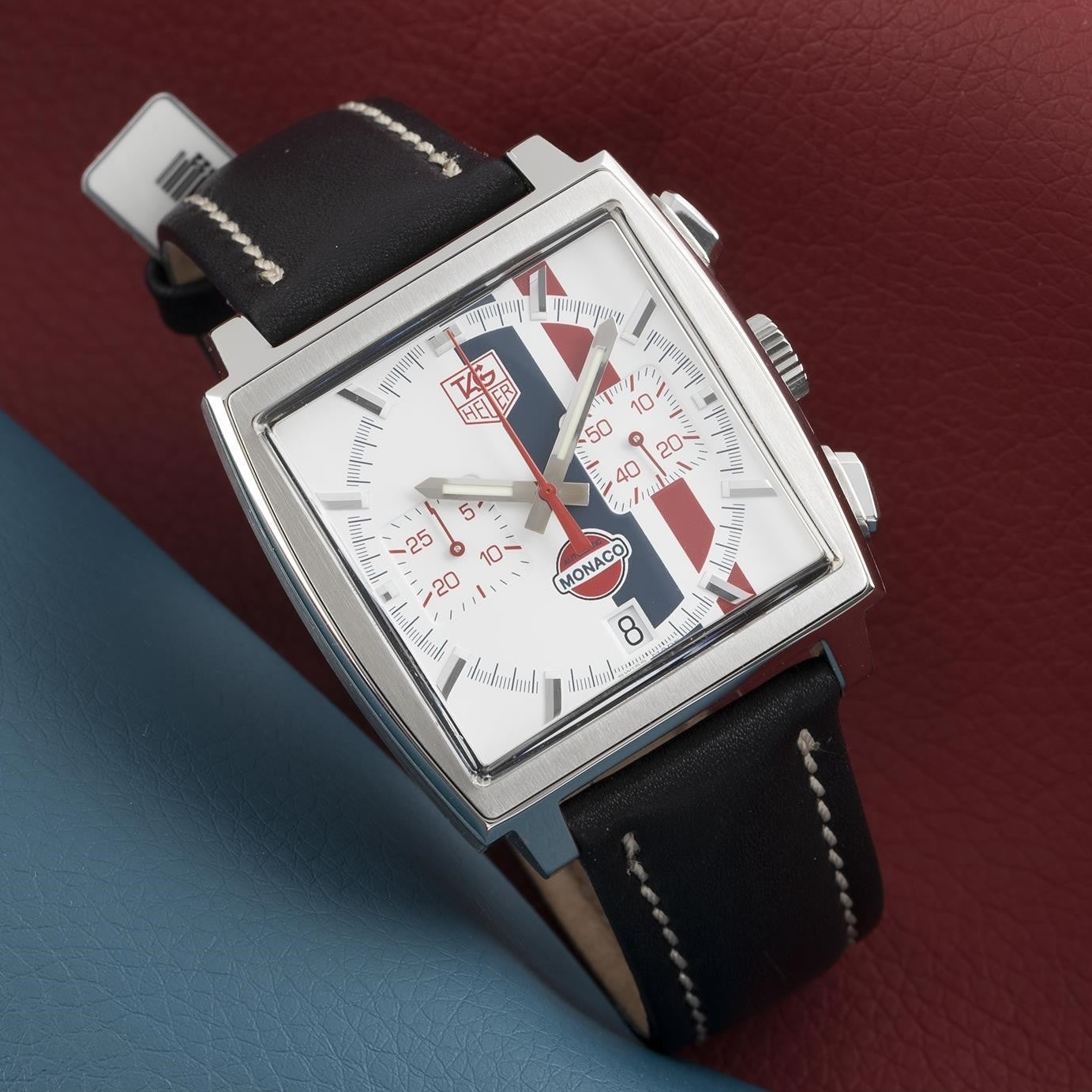
2008-2009 – The Modern Classics
At the end of the 2000s, Monaco received a thorough update. Ref. CAW2110 (black dial) and CAW2111 (blue dial), introduced in 2008–2009, featured larger 39mm by 39mm cases, sapphire crystals front and back, and the Calibre 12 (ETA 2892-2 base). These refreshed models offered improved ergonomics while keeping the vintage cues intact. They quickly became the backbone of the Monaco line and remained in production for years.
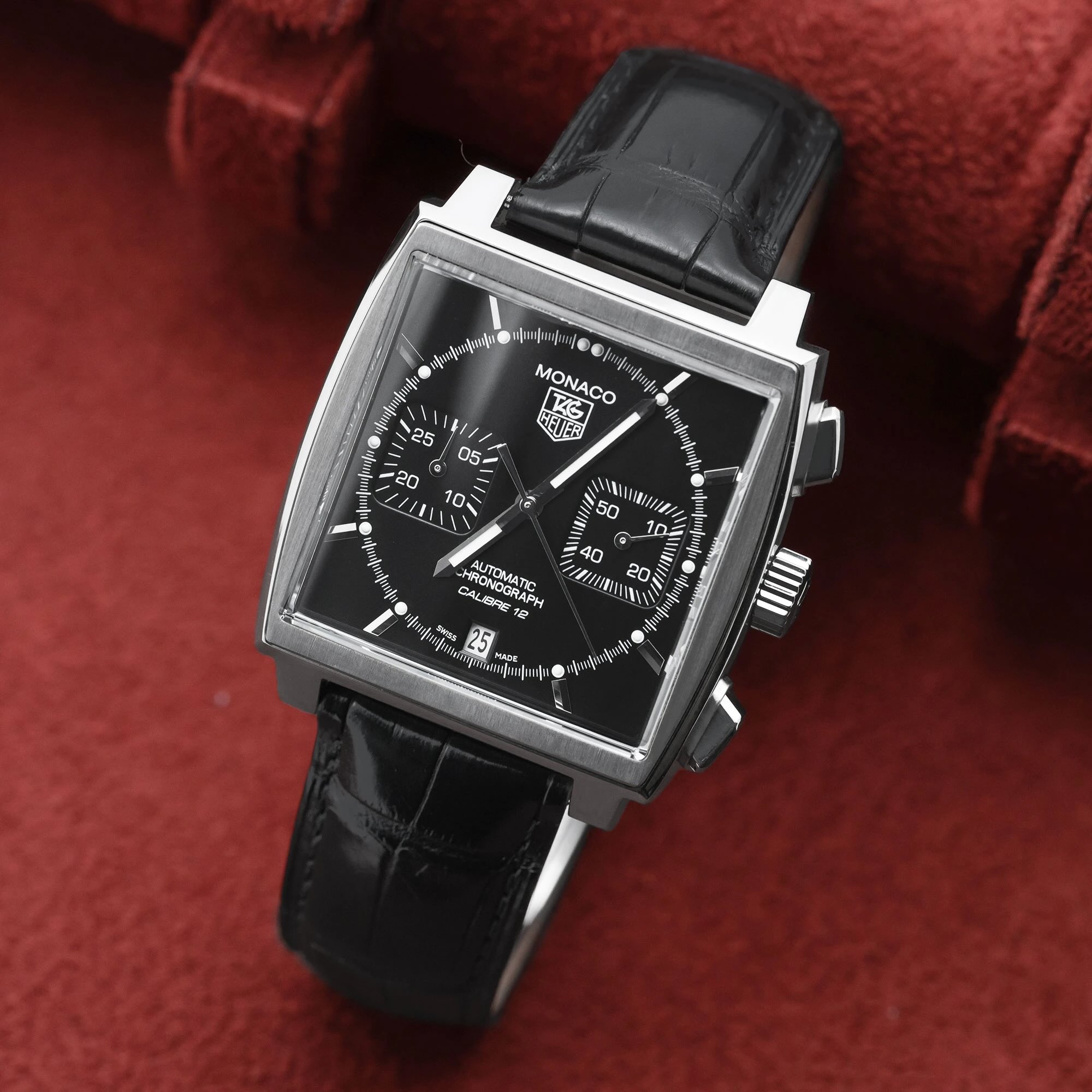
2009 – The 40th Anniversary and the Monaco V4
The Monaco’s 40th anniversary was marked in 2009 with two landmark releases that underscored both its heritage and its future.
The first was the CAW211A, a faithful re-creation of the 1969 Monaco reference 1133B, the “McQueen Monaco.” Unlike the earlier 1997 re-edition, which had modernised both case and dial, the CAW211A aimed for historical accuracy. Its 39mm case was nearly identical in geometry to the original, with polished and brushed facets faithfully restored. Most significantly, the crown was placed at 9 o’clock, just as it had been on the pioneering Calibre 11 models, immediately signalling its connection to the left-side-crown icon of 1969.
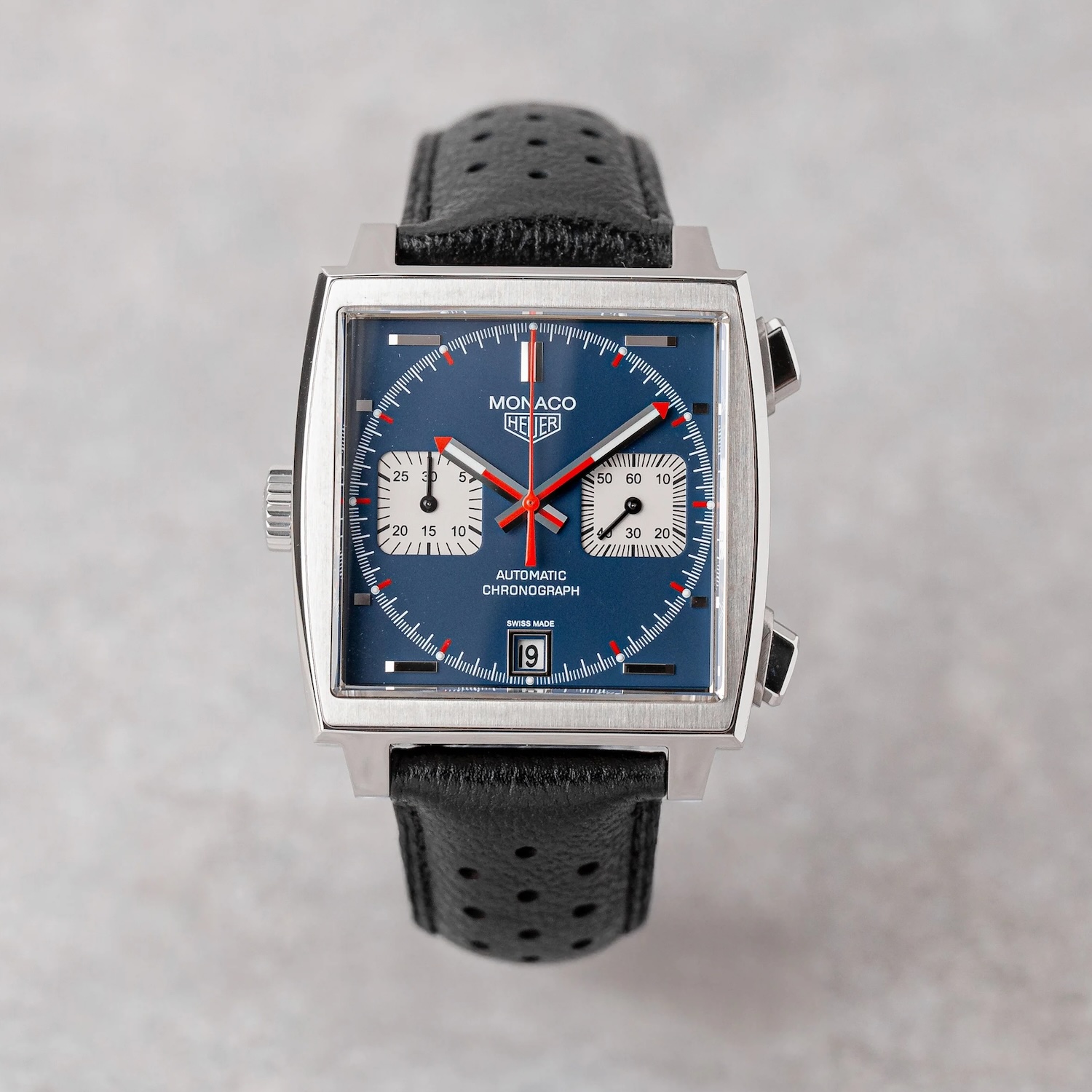
The dial was a vivid sunburst blue, fitted with two white square registers at 3 and 9 o’clock, a red central chronograph hand, and horizontal indices filled with luminous material. The date window at 6 o’clock and the applied Heuer shield (not TAG Heuer) above the word “Monaco” further reinforced its vintage character, though a domed sapphire crystal replaced the old mineral glass, improving durability without compromising aesthetics.
Inside was TAG Heuer’s modern Calibre 11, based on an ETA 2892-A2 with a Dubois-Dépraz chronograph module. Beating at 28,800 vibrations/hour, it provided a 40-hour power reserve and offered modern reliability while retaining the visual charm of the left-hand crown layout.
The CAW211A was produced in a limited run of 1,000 numbered pieces, each supplied with a blue alligator strap fitted with a Heuer-signed folding clasp. The caseback bore a special engraving marking “40 Years of Monaco – Limited Edition” alongside Jack Heuer’s signature. For many collectors, this was the first Monaco re-edition that felt like a true tribute rather than a reinterpretation, cementing the watch’s reborn status as an icon.
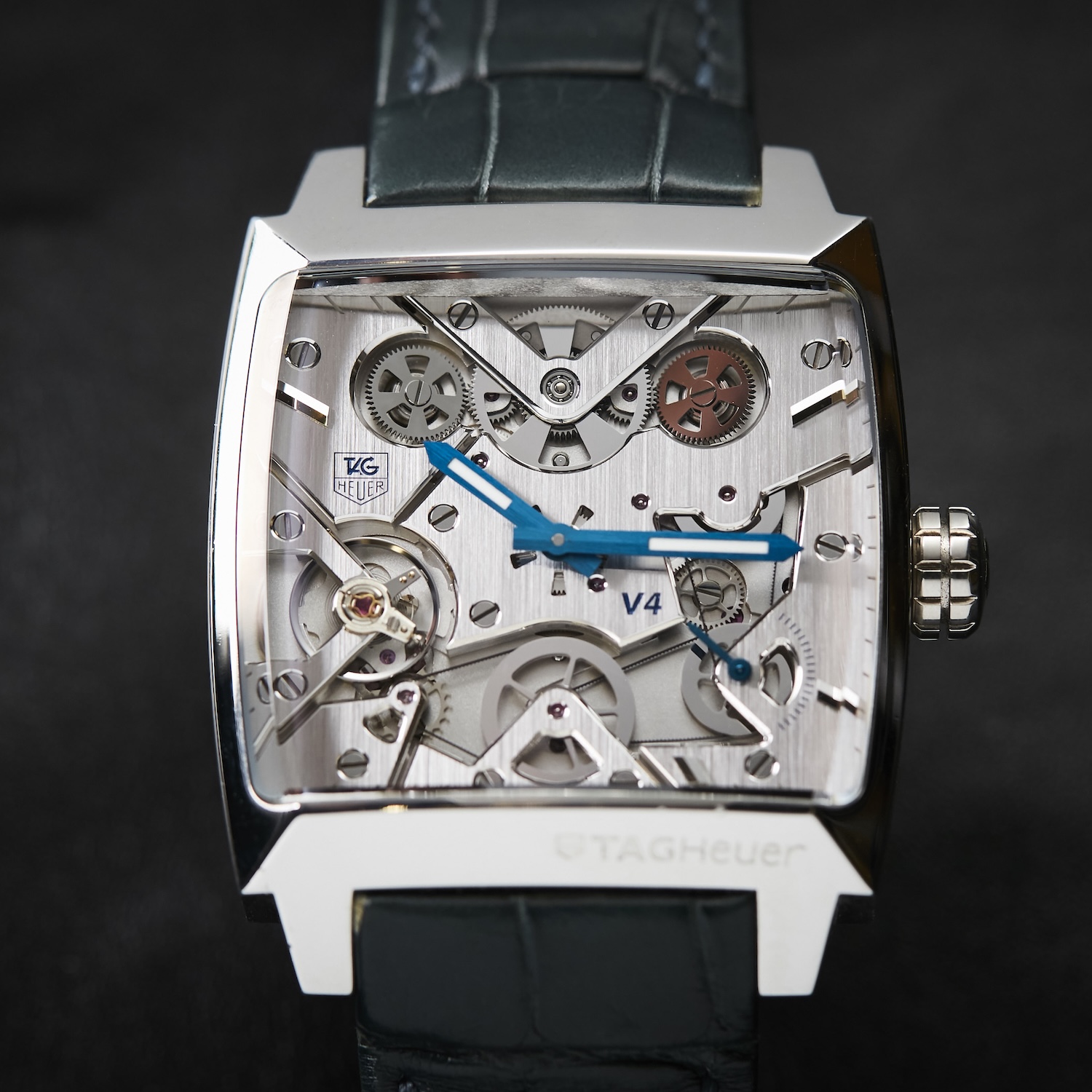
If the CAW211A represented the faithful homage to Monaco’s past, the other 2009 release, the Monaco V4 (WAW2170), embodied its ambitions. Announced as a concept in 2004 and finally delivered in 2009, the V4 was the world’s first belt-driven mechanical watch. Four barrels arranged in a V-shape, reminiscent of a racing engine block, transmitted energy via high-tech belts and mounted on micro ball bearings. Even the winding mass defied convention, sliding linearly on rails rather than rotating. Housed in a 41mm platinum case with sapphire front and back, the V4 was limited to 150 pieces and represented the bleeding edge of horological engineering. Together, the CAW211A and the Monaco V4 framed the collection’s dual identity: one foot in faithful vintage tribute, the other in avant-garde innovation.
2015-2025 – The Modern Times
2015 – The McQueen Revival
By 2015, TAG Heuer decided it was time to bring back the Monaco in its most authentic form yet. The result was the Monaco Calibre 11 “Steve McQueen” ref. CAW211P, a full-production model that finally captured the near 100% look and feel of the original 1133B. While the 2009 40th Anniversary ref. CAW211A had already re-created the vintage style; it was limited to 1,000 pieces and quickly became unattainable. The CAW211P, by contrast, entered the permanent catalogue.
The watch measured 39mm by 39 mm, with brushed and polished steel surfaces and a sapphire crystal. Most importantly, its crown was left on the left side, just like the 1969 original, a detail collectors had long demanded. The matte blue dial, white registers, horizontal indices, and vivid red accents made it the closest modern equivalent to McQueen’s Le Mans watch. While not technically identical to the 1969 Chronomatic, the resemblance was strong enough to satisfy even purists.
2016 – A French Twist
The following year, TAG Heuer introduced a daring regional variant: the Monaco Calibre 11 France Edition ref. CAW211S.FC6375. Limited to 200 pieces and sold only in France, it was a darker, moodier take on the square chronograph. The dial was matte black, with creamy faux-patina lume on the hands and markers, evoking the vintage “Dark Lord.” Unlike the McQueen-inspired CAW211P, this version dropped the horizontal indices for a clean reversed-panda layout, with bold white registers against a black ground.
Red highlights on the hands and logo brought a splash of energy, while the watch retained the 39mm case, sapphire crystal, and left-hand crown. Beneath the dial, the same automatic Calibre 11 powered the display. Paired with a perforated racing-style strap borrowed from the Monza, the France Edition gave the Monaco a fresh personality, collectable and distinctive.
2017 – Gulf Redux
In 2017, TAG Heuer made official what collectors had long associated with the Monaco: its connection to Gulf Oil and McQueen’s Porsche 917K in Le Mans. The brand struck a global partnership with Gulf and launched the Monaco Gulf Special Edition CAW211R.FC6401, first shown in early 2018.
The watch kept the familiar 39mm case and Calibre 11 of the CAW211P but added Gulf’s unmistakable livery. A metallic blue dial was overlaid with bright blue and orange vertical stripes, with the Gulf logo positioned at 5 o’clock just above the date. White registers, red accents on the hands and markers, and a blue perforated leather strap with orange stitching completed the motorsport theme. On the wrist, it was bolder than the McQueen model, firmly rooted in racing history and lifestyle.
2019 – The 50th Anniversary
When the Monaco turned fifty in 2019, TAG Heuer avoided a single commemorative piece and instead unveiled five limited editions, each capturing the style of a different decade from 1969 to 2019. All shared the square 39mm steel case, left-hand crown, sapphire crystal, and the Calibre 11 automatic chronograph, but each stood out through its dial and finishing, presenting five distinct personalities.
The 1969–1979 Limited Edition ref. CAW211V, launched at the Monaco Grand Prix, embraced the bold aesthetic of the 1970s. Its deep green dial was decorated with a vertical Côtes de Genève-style striping pattern, accented by bright yellow and brown details on the markers and hands. The squared registers carried a grainy silver finish, contrasting with polished horizontal indices.
The 1979–1989 Limited Edition ref. CAW211W, presented at Le Mans, celebrated the fiery spirit of the turbocharged 1980s. Its dial was finished in a sunburst red that shifted from dark burgundy to bright scarlet under light. Instead of the usual square subdials, it featured cushion-shaped rhodium registers, horizontally brushed for texture. Bold white framing around the date at 6 o’clock anchored the vivid design.
The 1989–1999 Limited Edition ref. CAW211X, unveiled in New York, reflected the gritty industrial style of the 1990s. Its dial surface was heavily grained and rhodium-plated, creating a matte metallic effect. The sub-registers added contrast with sandblasted centres and blue tracks, while splashes of red on the hands and markers added a motorsport edge.
The 1999–2009 Limited Edition ref. CAW211Y, introduced in Tokyo, moved toward a racing-inspired minimalism. It used a stark black opaline dial paired with crisp white subdials, giving it a reversed-panda effect. A bold circular minute track stood out against the squared architecture of the watch, while red and orange highlights on the central hands and markers delivered high legibility and a nod to motorsport dashboards.
The 2009–2019 Limited Edition ref. CAW211Z, the final piece of the anniversary cycle, reflected the modernism of the 2010s. The sunray charcoal dial shimmered between grey and black tones, paired with rhodium-brushed sub-registers. All inscriptions were black, while the faceted indices and hands were finished in black-gold plating, giving the dial a near-monochrome appearance. The only interruptions were the bright red chronograph hands. A sandblasted case finish, unique among the five editions, reinforced the minimalist design language.
Each edition was limited to 169 pieces and delivered in a presentation box decorated in the colours and motifs of its decade. All together, they offered a retrospective of the Monaco’s history, and were a celebration of its remarkable adaptability, proving how a single square case could host fifty years of evolving design without losing its unmistakable character.
2019 – The Heuer 02 Era Begins
After the five anniversary editions, TAG Heuer gave the standard Monaco a major technical update. The long-serving Calibre 12 (Sellita/ETA base with Dubois-Dépraz module) was retired (with a cool, grey-dialled Monaco Calibre 12 Final Edition released to say goodbye), and in its place came the Monaco Heuer 02 ref. CBL2111. While visually similar to the outgoing CAW2111, a blue sunburst dial, applied radial indices, white registers, and red chronograph accents, the watch now housed TAG Heuer’s fully integrated in-house chronograph.
The Heuer 02 is a 31mm automatic movement with a column wheel and vertical clutch, running at 28,800 vibrations/hour with an 80-hour power reserve. Its architecture allowed the Monaco to adopt a tri-compax layout: 30-minute and 12-hour counters at 3 and 9 o’clock, with a discreet small seconds at 6 that shares space with the date. The case retained its 39mm size but gained in thickness. A larger sapphire display back revealed the blackened rotor and red column wheel.
The shift to the Heuer 02 calibre marked an important milestone: from 2019, the Monaco would no longer rely on modular outsourced movements, but instead on TAG Heuer’s own chronograph calibre.
2022-2023 – The Return of the Dark Lord, and the Night Driver
In 2022, TAG Heuer revived one of the most coveted vintage Monacos, the all-black “Dark Lord” of the 1970s. The Monaco Special Edition in DLC-coated titanium ref. CBL2180.FC6497 translated the stealth aesthetic into modern form.
The 39mm case was crafted from lightweight grade 5 titanium and entirely coated in matte black DLC. The dial followed suit, with a sandblasted black surface contrasted by rose-gold indices and hands. Through the sapphire back, the in-house Heuer 02 provided the same tri-compax layout and 80-hour reserve. This contemporary Dark Lord wasn’t a faithful re-edition but a reinterpretation, combining vintage mystique with 21st-century finishing.
Building on the Dark Lord’s stealth presence, TAG Heuer introduced a striking twist in 2023: the Monaco Chronograph Night Driver ref. CBL2181.FC6515. Like the Dark Lord, its 39mm case was grade 5 titanium with a black DLC finish, but its dial introduced a unique transformation. By day, the dial appeared muted in layered greys: an anthracite centre with lighter grey outer track and subdials, finished with a grainy matte texture. Applied black indices and lacquered hands kept the monochrome theme intact. But in darkness, the entire outer dial and chronograph registers glowed bright blue, thanks to full-surface Super-LumiNova treatment. The effect was dramatic, a square of electric light, unlike anything seen on a Monaco before.
2023 – The Skeleton Series
Also unveiled in 2023 was perhaps the most radical evolution of the Monaco yet: the Monaco Skeleton Chronograph, the first openworked dial in standard production. Three variants debuted – Original Blue (CBL2182), Racing Red (CBL2183), and Turquoise DLC (CBL2184).
All shared a 39mm grade 2 titanium case (sandblasted for a matte look, with a black DLC for the turquoise edition), 100m water resistance, and the Heuer 02 movement visible from both sides. The dials departed dramatically from tradition: sharp, architectural cut-outs revealed the movement beneath, with angular bridges and reshaped sub-registers. Radial indices pointed inward from the periphery, reinforcing the square-in-circle geometry. Super-LumiNova accents enhanced legibility, giving the watches a glowing, futuristic aesthetic.
Each colourway carried its own personality. The Original Blue paired a titanium case with a blue dial and strap, highlighted by white and red accents and a blue column wheel. The Racing Red used black with vivid red details, including a red column wheel and rotor engravings. The Turquoise DLC was the boldest: a fully black case and strap offset by turquoise markers, counters, and column wheel. These skeleton Monacos abandoned nostalgia altogether, pushing the design toward a more avant-garde, high-tech identity, modern companions to the traditional McQueen-inspired CAW211P.
2024 – Enter The Rattrapante
In 2024, the Monaco took one of its boldest steps yet by venturing into split-second chronograph territory. The complication, often regarded as the pinnacle of chronograph design, had appeared in Heuer stopwatches of the 1960s but never in a Monaco wristwatch. That changed with the debut of the Monaco Split-Seconds Chronograph (references CBW2181 and CBW2182), powered by the new TH81-00 calibre, developed in collaboration with Vaucher Manufacture Fleurier.
The case was enlarged slightly to 41mm by 41mm and crafted from Grade 5 titanium, topped by a polished sapphire bezel and bevelled domed crystal. The movement dictated some functional design choices: the rattrapante pusher was positioned at 9 o’clock, with low titanium guards to balance the case. Dial-side, the watches combined a transparent sapphire base with bold accents, red on the CBW2181, blue on the CBW2182, set against multi-layer bridges and skeletonised hands. The central split-seconds hand, chronograph registers at 3 and 9 o’clock, and finely engraved scales gave the dial a sense of depth and mechanical drama.
The TH81-00 calibre is a fully integrated high-frequency split-seconds chronograph, running at 36,000 vibrations/hour with a 65-hour reserve (55 hours with the chronograph engaged). Its design is descended from Vaucher’s VMF 6710 architecture, known from Parmigiani’s Chronor Anniversaire and Richard Mille’s RM 65-01, but adapted extensively for TAG Heuer. Titanium components, a hand-painted oscillating rotor in the shape of the TAG shield, and a chequered-flag bridge motif tied the movement directly to racing heritage.
This Monaco marked the brand’s return to complications at the very highest level, as a statement that TAG Heuer could once again compete in the same field as haute horlogerie’s elite split-second.
2025 – White Ceramic and TH Titanium, Materials Innovation
The following year, TAG Heuer pushed boundaries further with one of its most unexpected Monacos yet: the Monaco Split-Seconds Chronograph F1 Edition (reference CBW2190). Introduced in early 2025, the watch celebrated TAG Heuer’s return as the Official Timekeeper of Formula 1.
Instead of titanium, the case was made of white ceramic, a first for the Monaco. Measuring 41mm by 41mm, the case, pushers, and crown were all executed in brushed and polished white ceramic, accented with a red titanium rattrapante pusher at 9 o’clock and a lacquered TAG Heuer shield on the crown. A red-tinted sapphire dial revealed bold white ceramic bridges arranged in an “X” motif, with applied white lume indices and chronograph counters in black graining with red and yellow details. The central chronograph hand was lacquered white, while the split-seconds hand blazed in red. The dial also bore a playful nod to Formula 1: printed across the counters were the words “LIGHTS OUT” and “AWAY WE GO”, echoing the famous starting command of every Grand Prix.
Later in 2025, TAG Heuer introduced another material breakthrough with the Monaco Split-Seconds Chronograph TH Titanium (reference CBW2185). Developed over four years at the brand’s La Chaux-de-Fonds laboratory, TH Titanium is a proprietary alloy transformed at the atomic level by a thermal process that reveals natural, irregular patterns under light.
The result was a Monaco unlike any before: a 41mm-by-41mm case weighing only 86 grams, its faceted surfaces shifting subtly with every angle. Lime-green accents energised the transparent sapphire dial, from the split-seconds hand to the lacquered markings and stitching on the strap. As with earlier editions, the TH81-00 calibre provided the mechanical core. Unlike the ceramic F1 limited edition, the TH Titanium Monaco entered the permanent collection.
2025 – The Carbon Revolution
If 2024 was the year of the rattrapante, then 2025 marked the return of TAG Heuer’s most ambitious movement experiment: the TH-Carbonspring oscillator. Nearly a decade in development, this hairspring built from carbon nanotubes had been tested in the Carrera Nanograph Tourbillon (2019), trialled (and stumbled) in the Autavia Isograph, and showcased in the Carbon Monaco Only Watch (2021). After years of refinement, the technology was declared ready for series production in 2025, debuting in two halo models: the Monaco Flyback Chronograph TH-Carbonspring and the Carrera Tourbillon Extreme Sport TH-Carbonspring.
The Monaco reference announced for availability in late 2025 stays true to its design DNA while embracing cutting-edge materials. A 39mm x 14.1mm case is made almost entirely of forged carbon, including the crown and pushers, making it both lighter and more rigid than steel. The dial, also in carbon, is engraved with a spiral pattern that directly references the geometry of the new oscillator. Three counters are arranged at 3 and 9 o’clock, with the running seconds at 6 o’clock kept deliberately understated. Carbon indices and hands treated with white Super-LumiNova keep the watch legible, while a white central chronograph seconds hand provides visual clarity.
The watch is powered by the new Calibre TH20-60, a COSC-certified automatic flyback chronograph delivering an 80-hour reserve. Its key distinction is regulation by the TH-Carbonspring, which is amagnetic, lighter than silicon, and virtually unbreakable under shock. The spring is grown in-house via a CVD process, producing a stable spiral with its collet formed as part of the structure, a technical achievement that removes one of the most failure-prone steps in traditional hairspring assembly.
The Carrera Tourbillon Extreme Sport TH-Carbonspring combined the same oscillator with a flying tourbillon regulator inside a Calibre TH20-61 movement. Together, these two watches signal that TAG Heuer’s long-running pursuit of a carbon-based alternative to silicon hairsprings has reached maturity. Where the Monaco Split-Seconds pushed complications to the extreme, the Carbon Monaco demonstrates that innovation can be embedded in the very heartbeat of the watch. More than half a century after its debut, the Monaco continues to serve as TAG Heuer’s laboratory for design, materials, and now, the future of chronometry.
Concluding Thoughts
More than fifty years after its debut in 1969 with the reference 1133B “Steve McQueen” Monaco: blue dial, white registers, red accents, and powered by the pioneering Calibre 11, the Monaco has proven itself endlessly adaptable. Early successors like the black-dial 1133G and the grey 1533N expanded the family in the 1970s, while modern revivals such as the CW2113 in 2003 reintroduced the blue “McQueen” layout with Calibre 17.
Concept pieces have underlined the Monaco’s experimental streak. The Monaco V4 of 2004 replaced the gear train with belts, while the Monaco 360 Concept of 2006 offered 1/100th-second timing from a central chronograph hand, not to mention the unique Monaco Mikrograph (2011).
Special and regional editions have broadened the canvas further. The Gulf-liveried CAW2113, the Japan-only midnight blue releases, and anniversary models like the 2019 Monaco Calibre 11 all carried distinctive dials and subtle details that kept the line relevant for collectors and appealing to “regular” watch buyers. The 2017 Bamford Edition, with its carbon case and luminous aqua-blue highlights, pushed the Monaco into modern streetwear territory, once again proving the square case could accommodate even the bravest ideas.
Together, the production Monacos, the concepts, the specials, the limited editions, the exclusives, and the themed and collaborative editions all point to one conclusion: the Monaco is not a relic, but a living project. Every iteration, whether a faithful re-edition or a radical departure, adds to its evolving story. Decades on, the Monaco’s story remains unfinished, still as square, bold, and uncompromising as it was on day one.
If I may add a personal note, I was never among the Monaco’s greatest admirers. Yet, in the process of researching and telling its story, I found myself warming to it in ways I never expected. The more I learned, the more it revealed, and somewhere along the way, I began to like it far more than I thought I ever would.



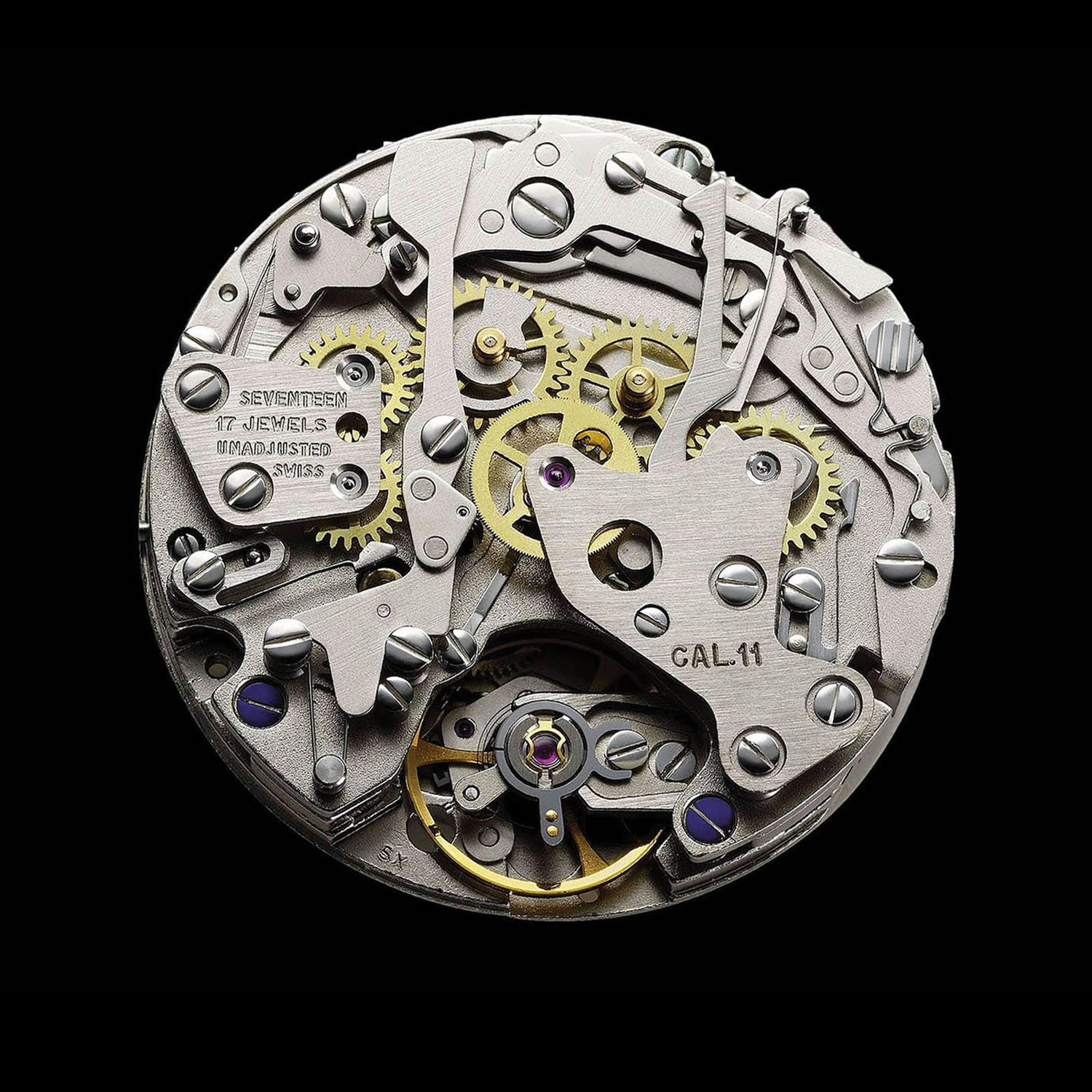


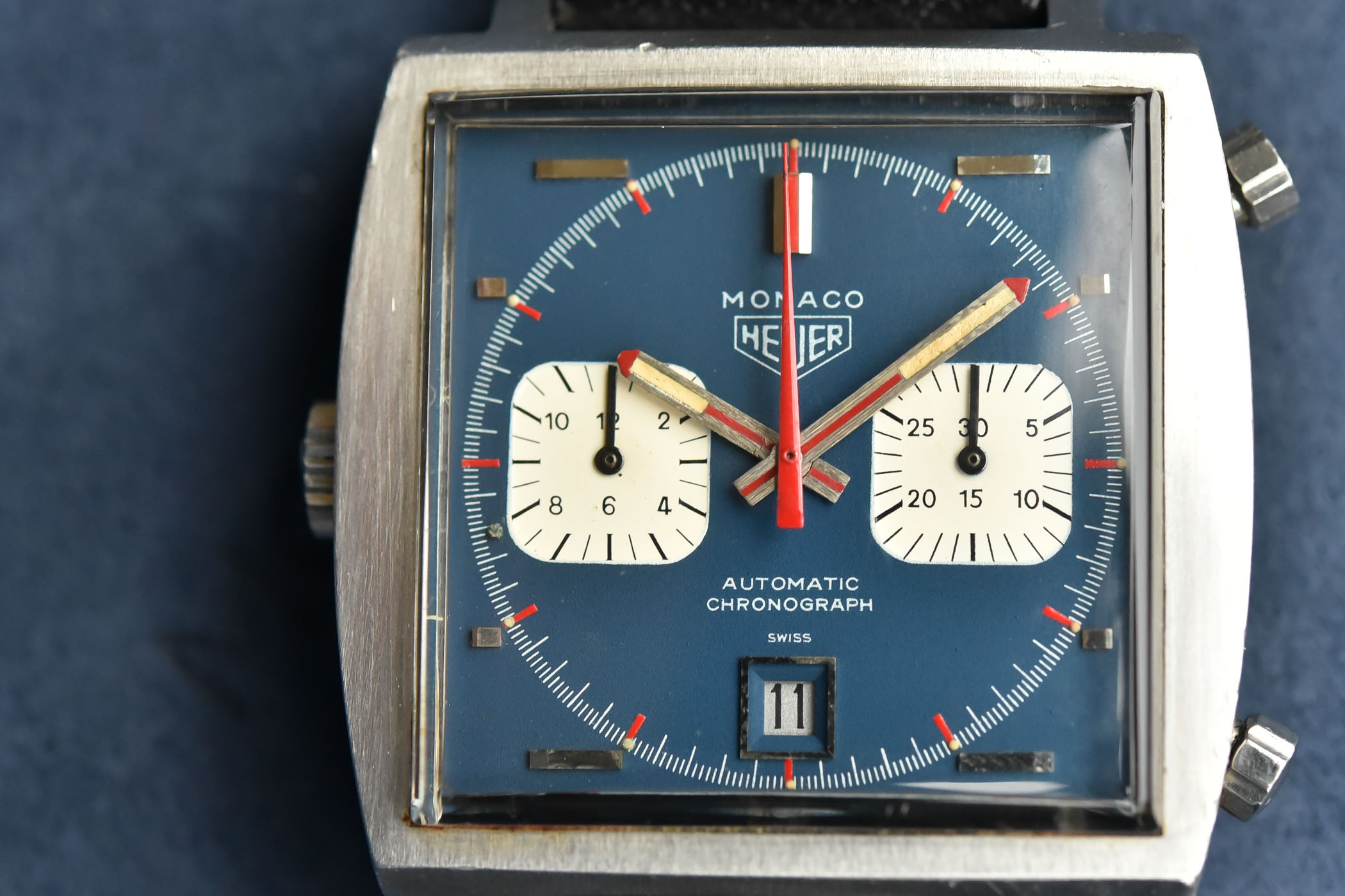










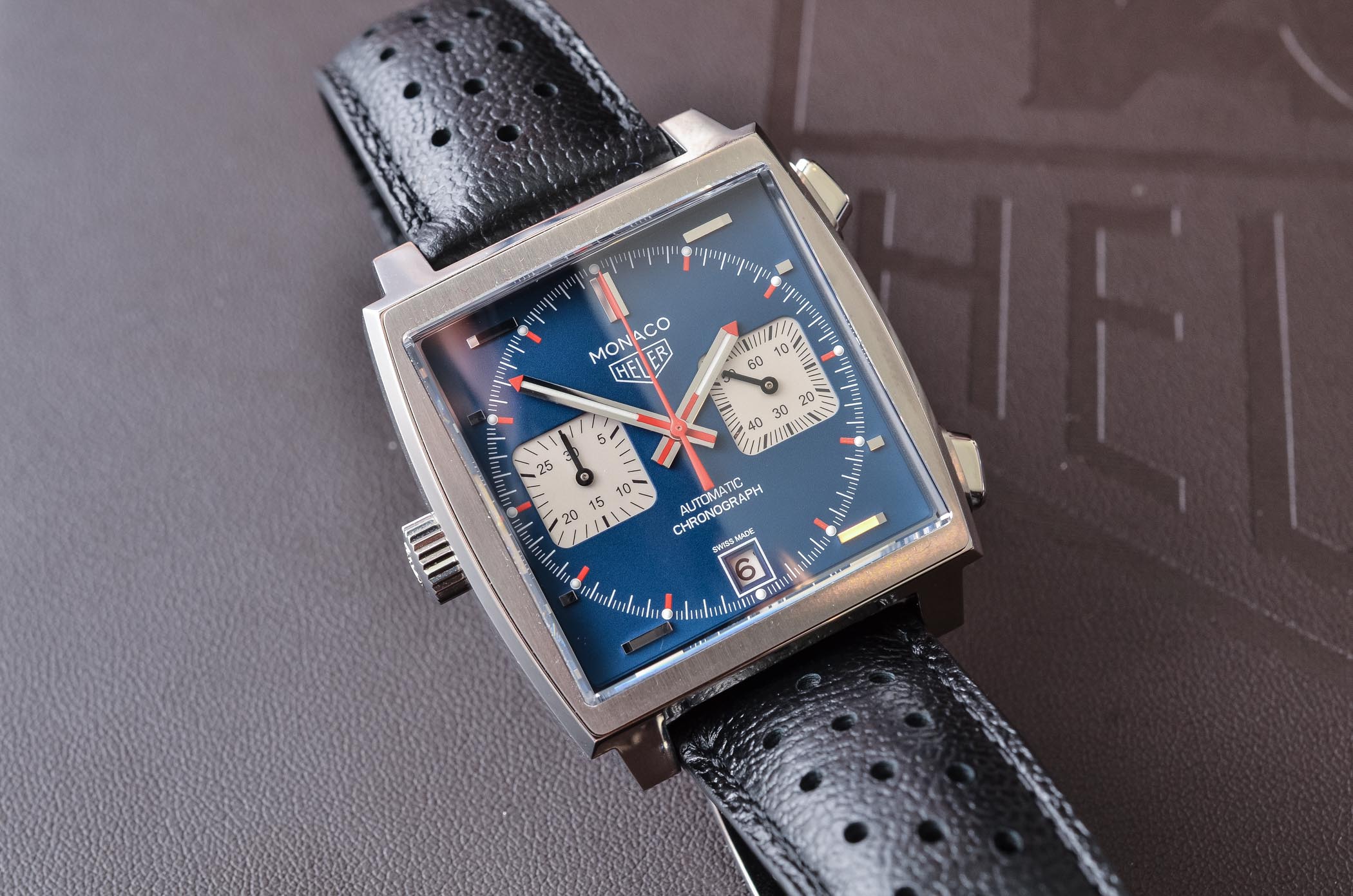
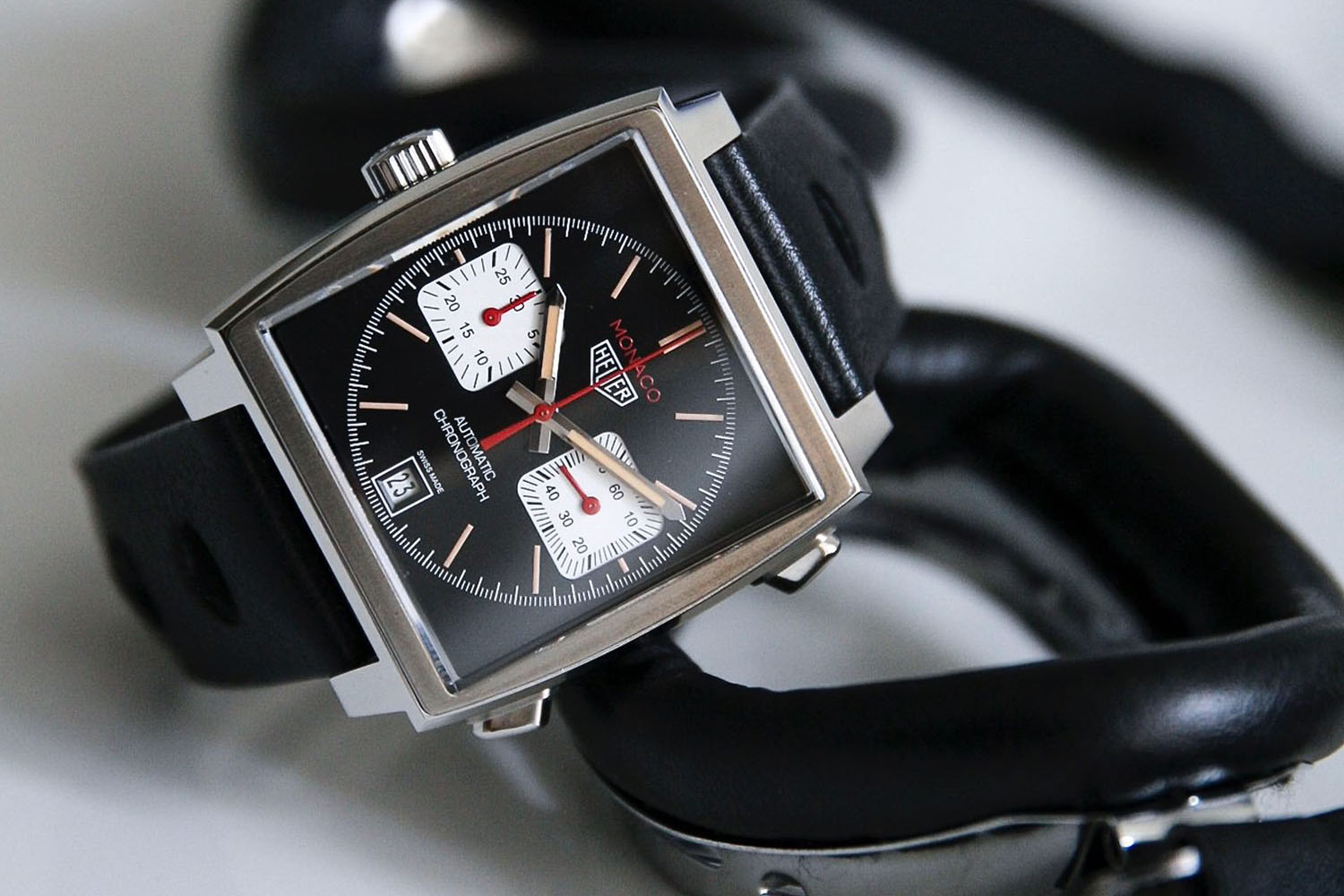
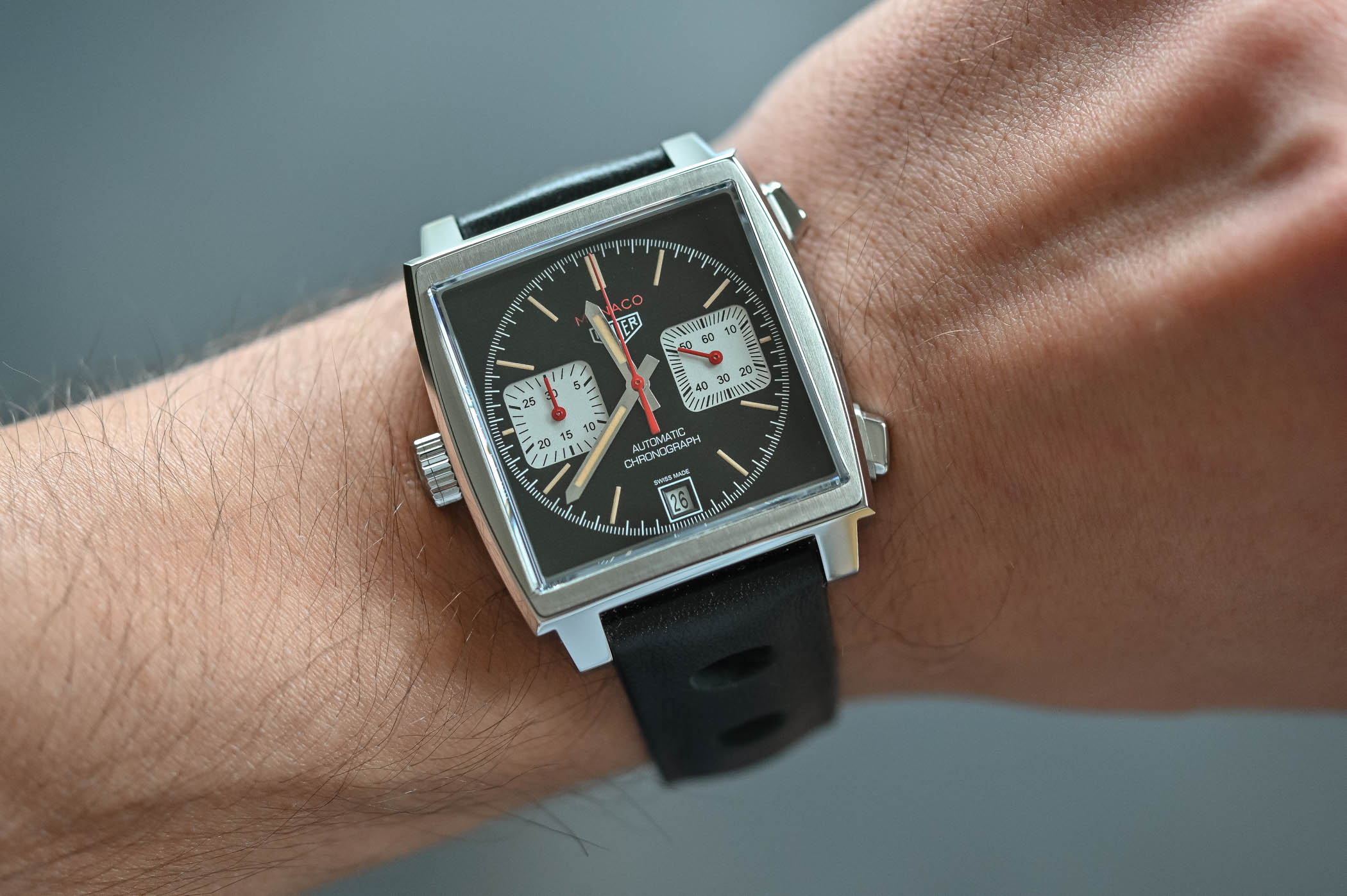
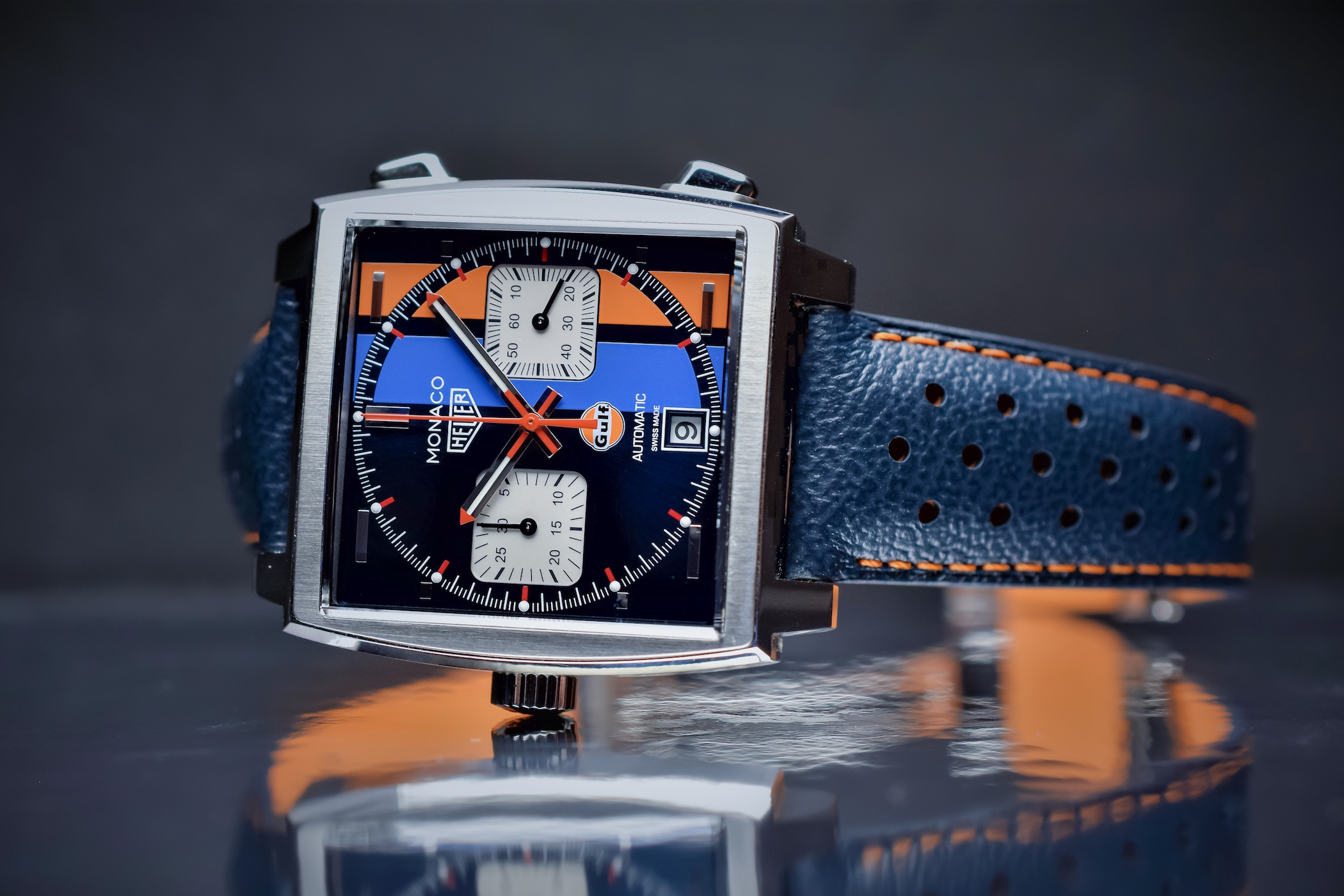
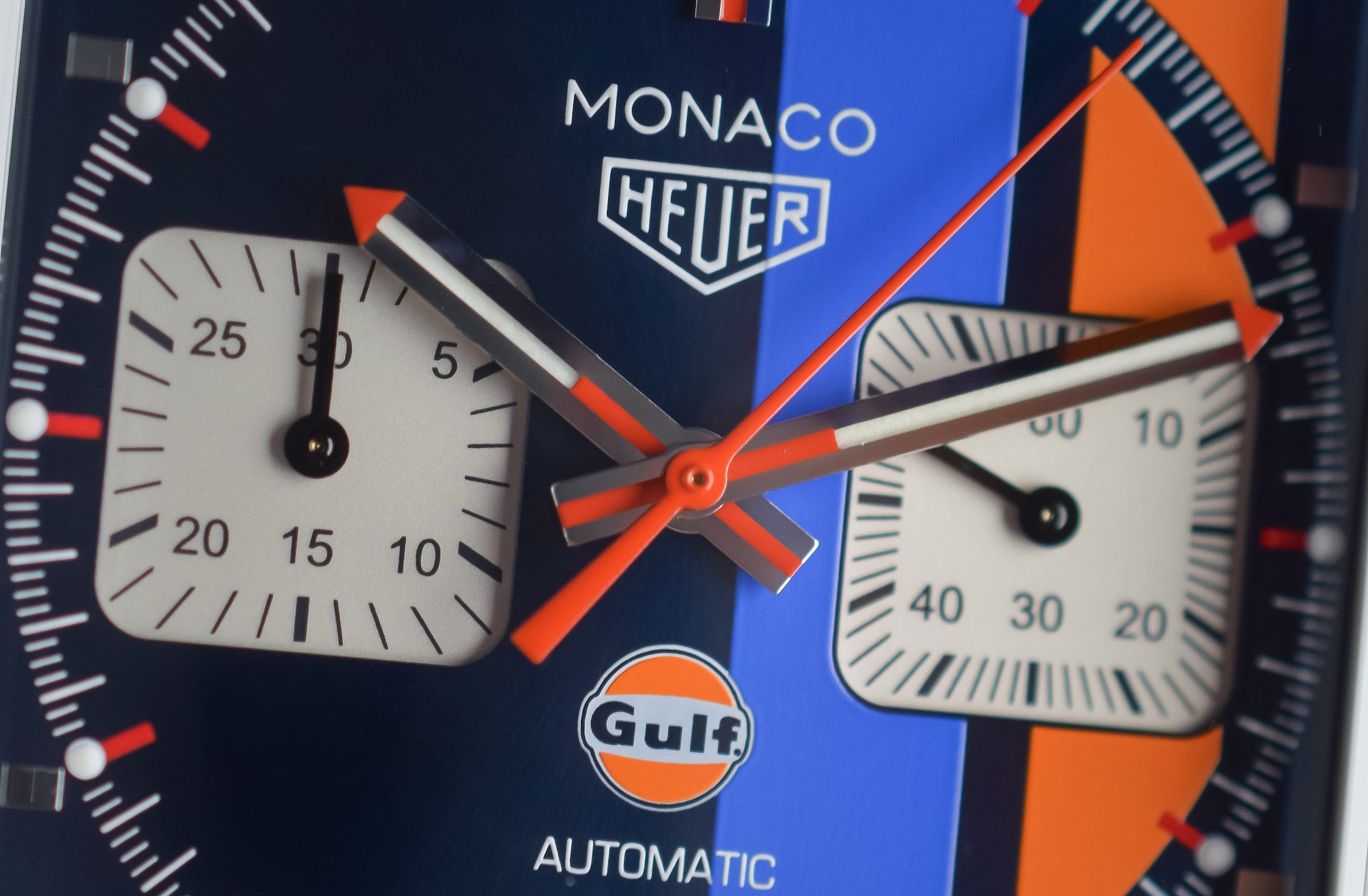
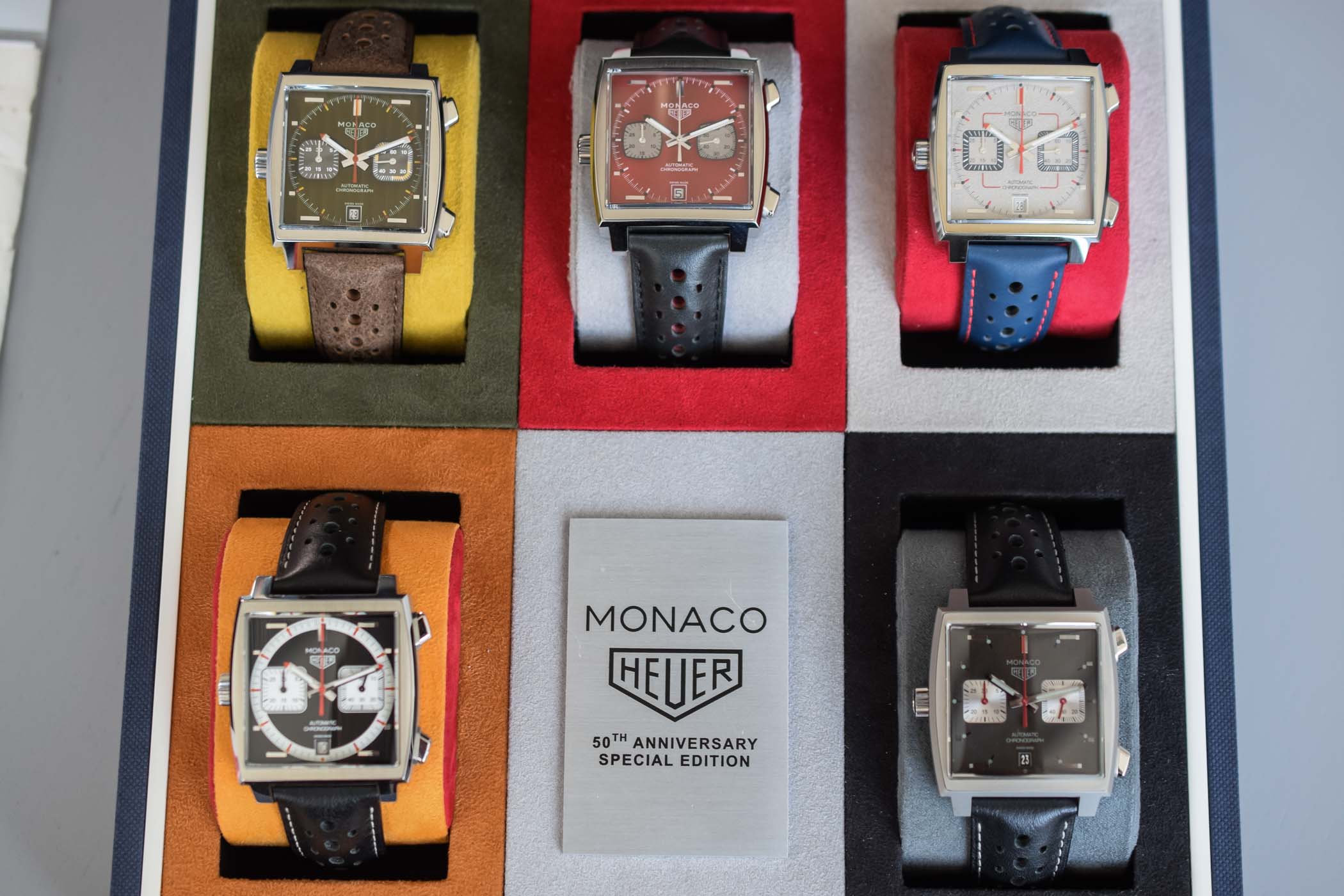
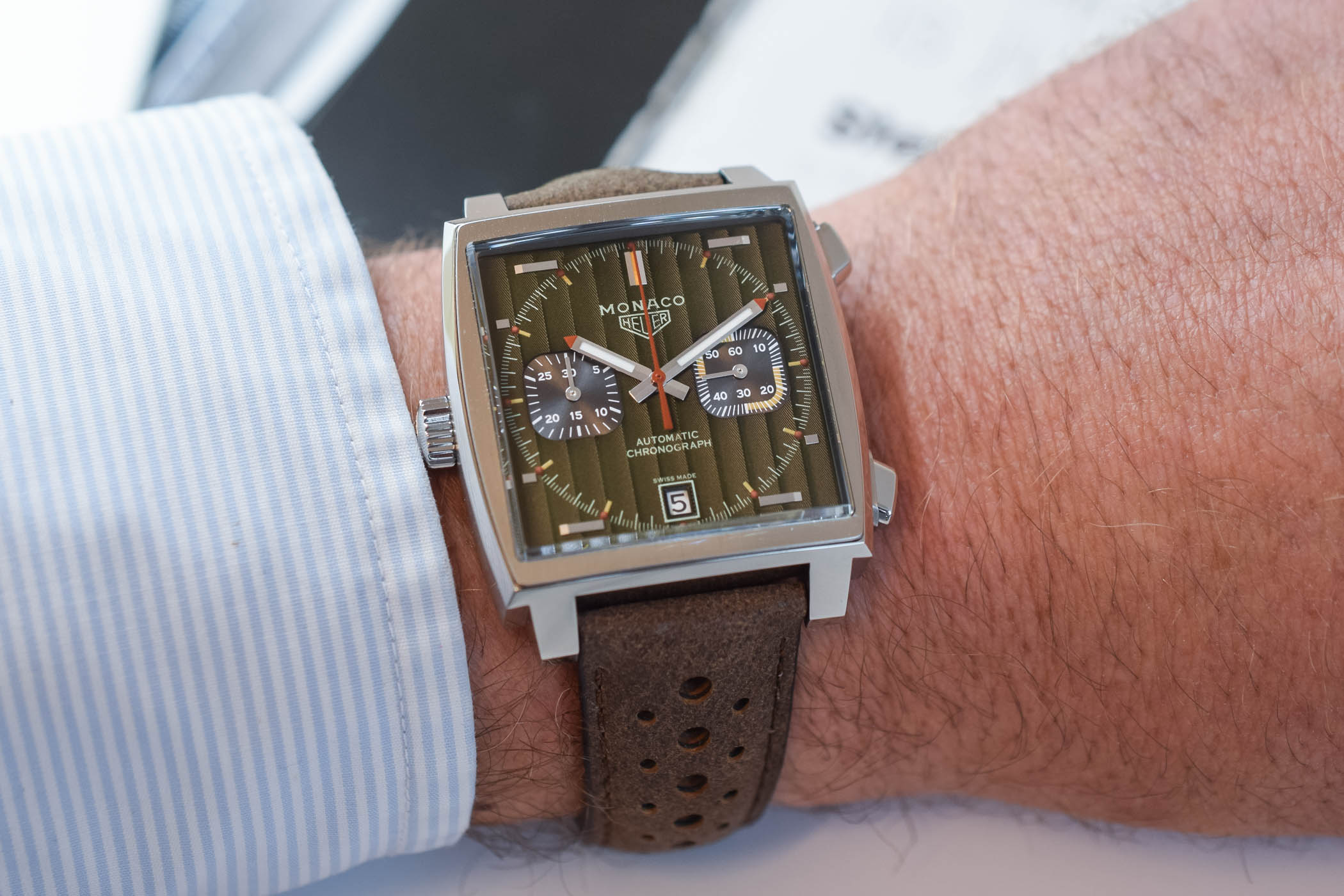
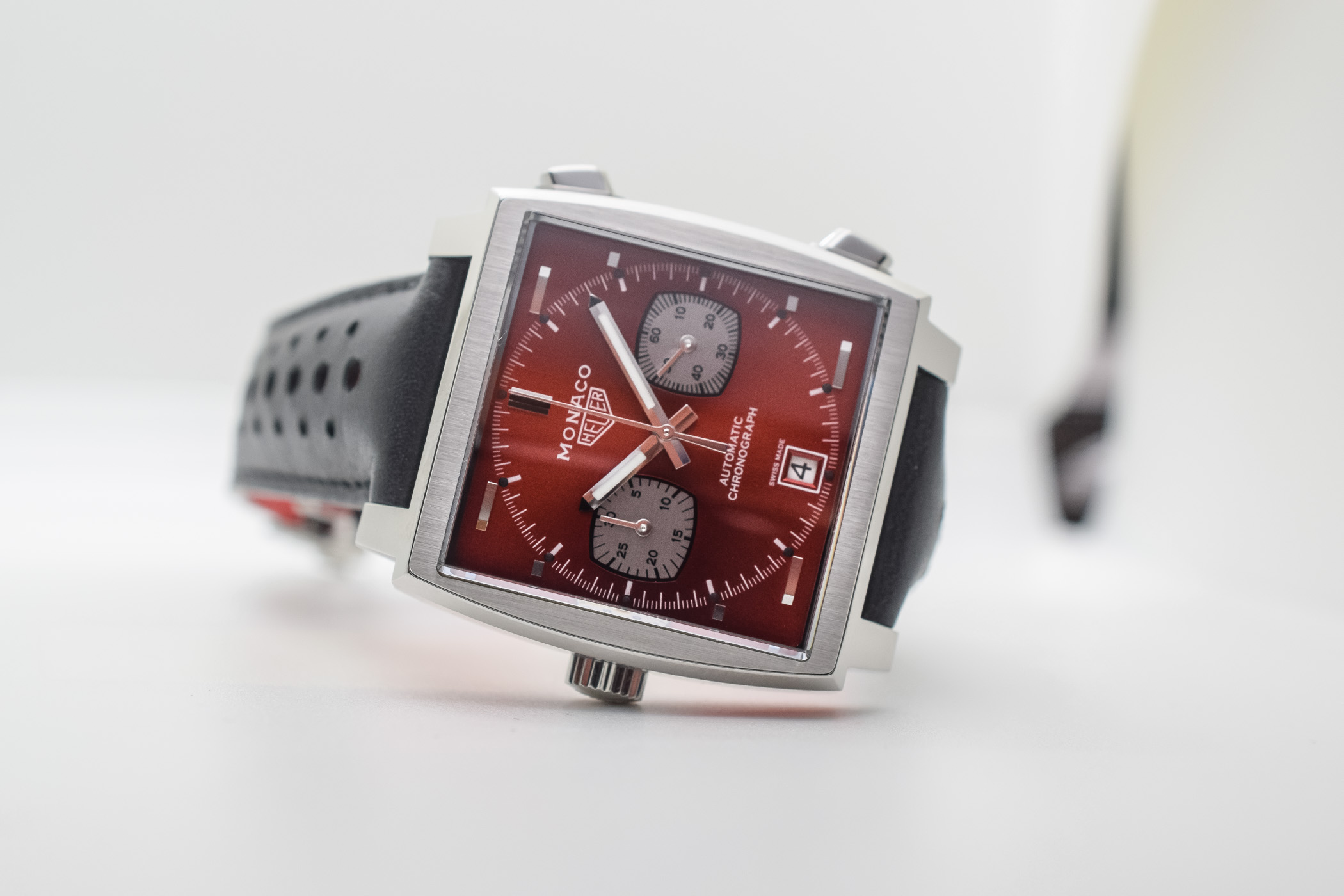
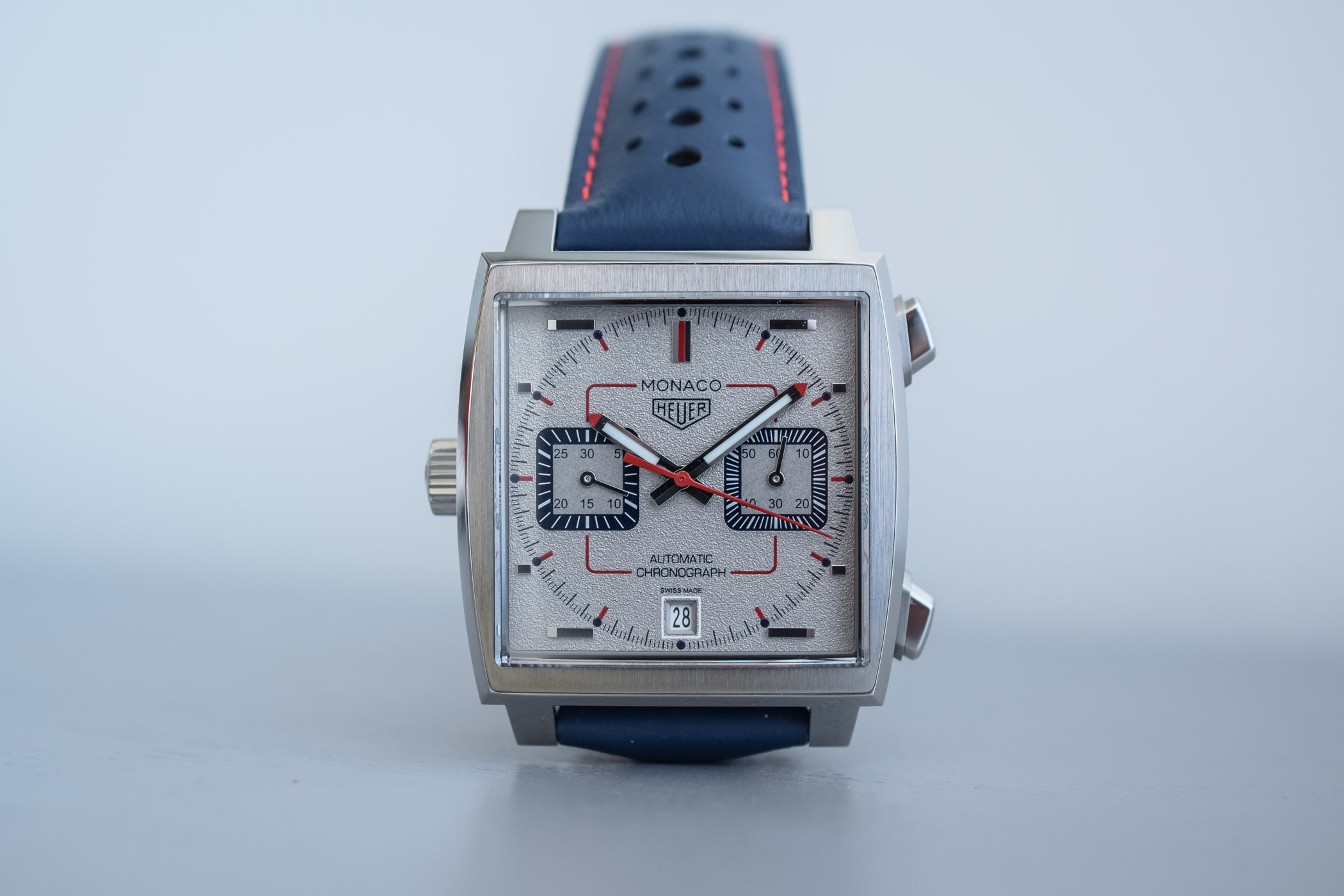
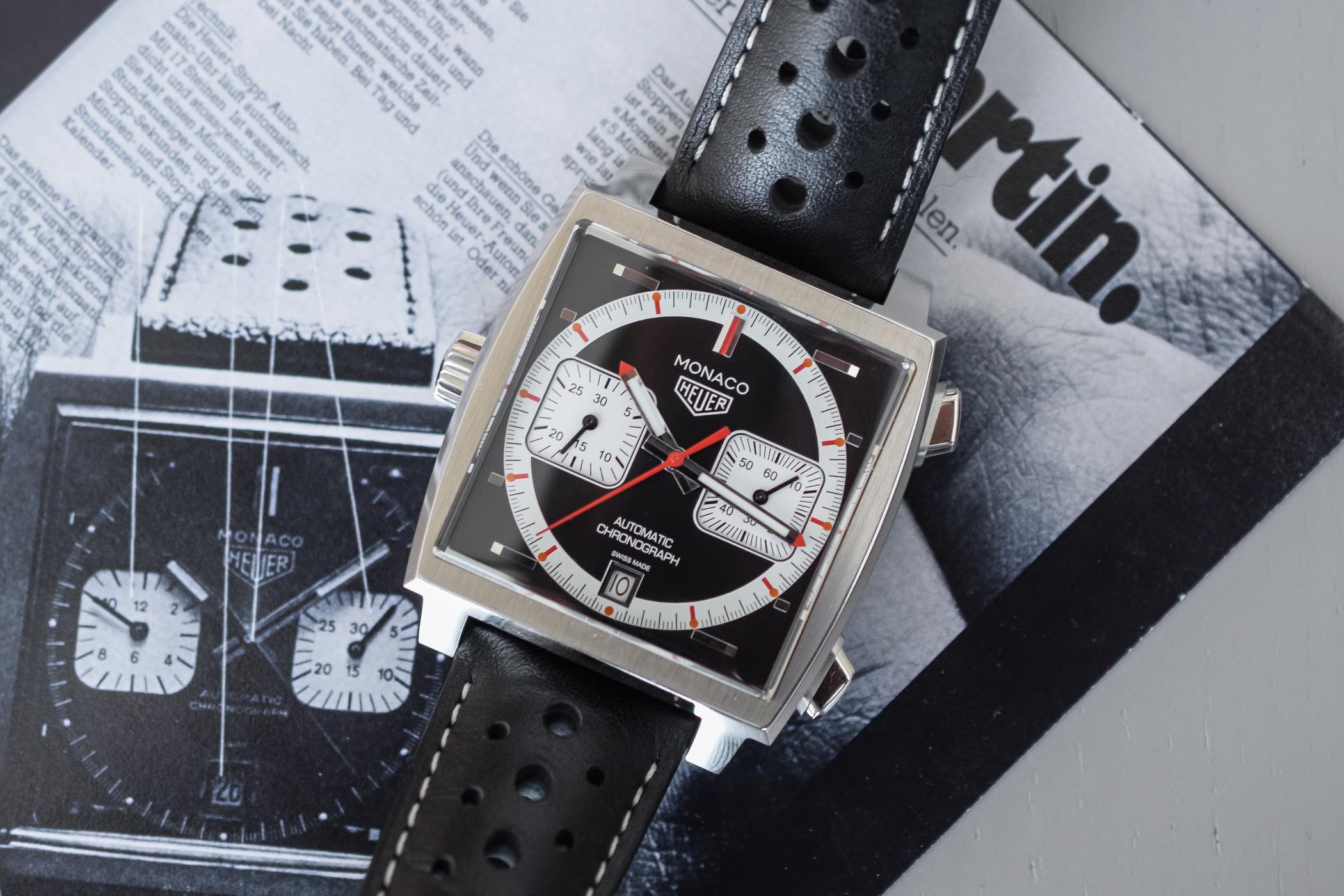
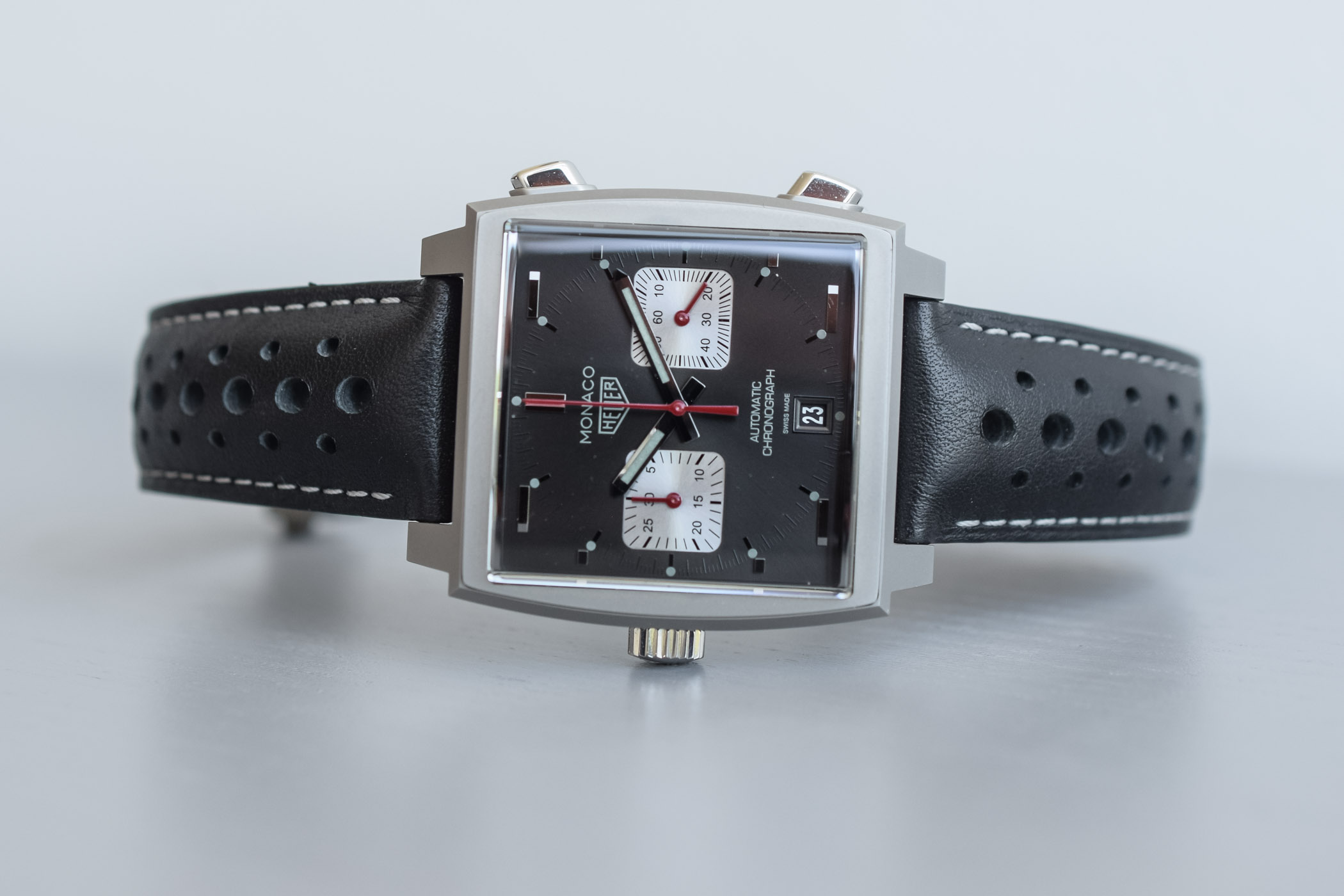
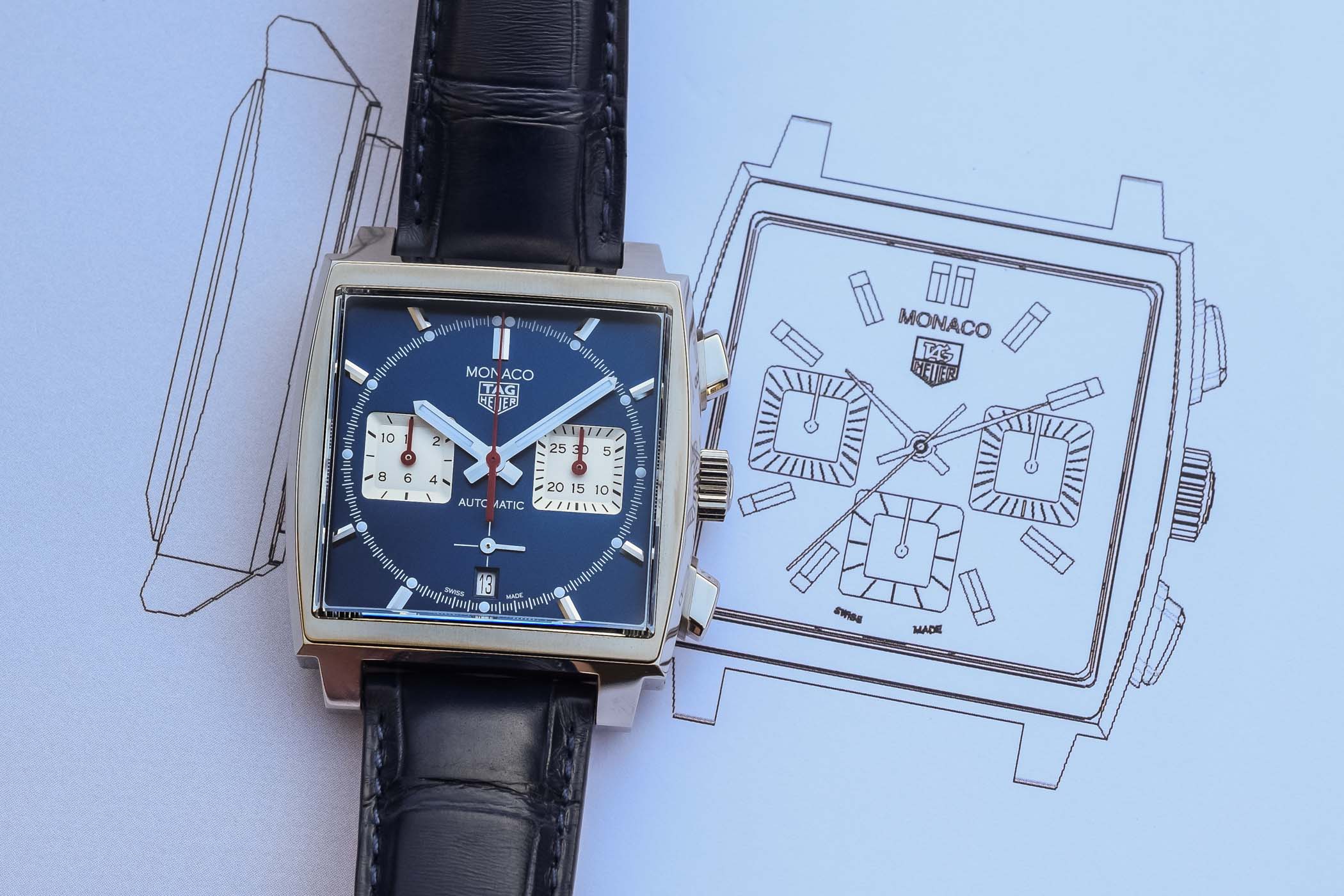
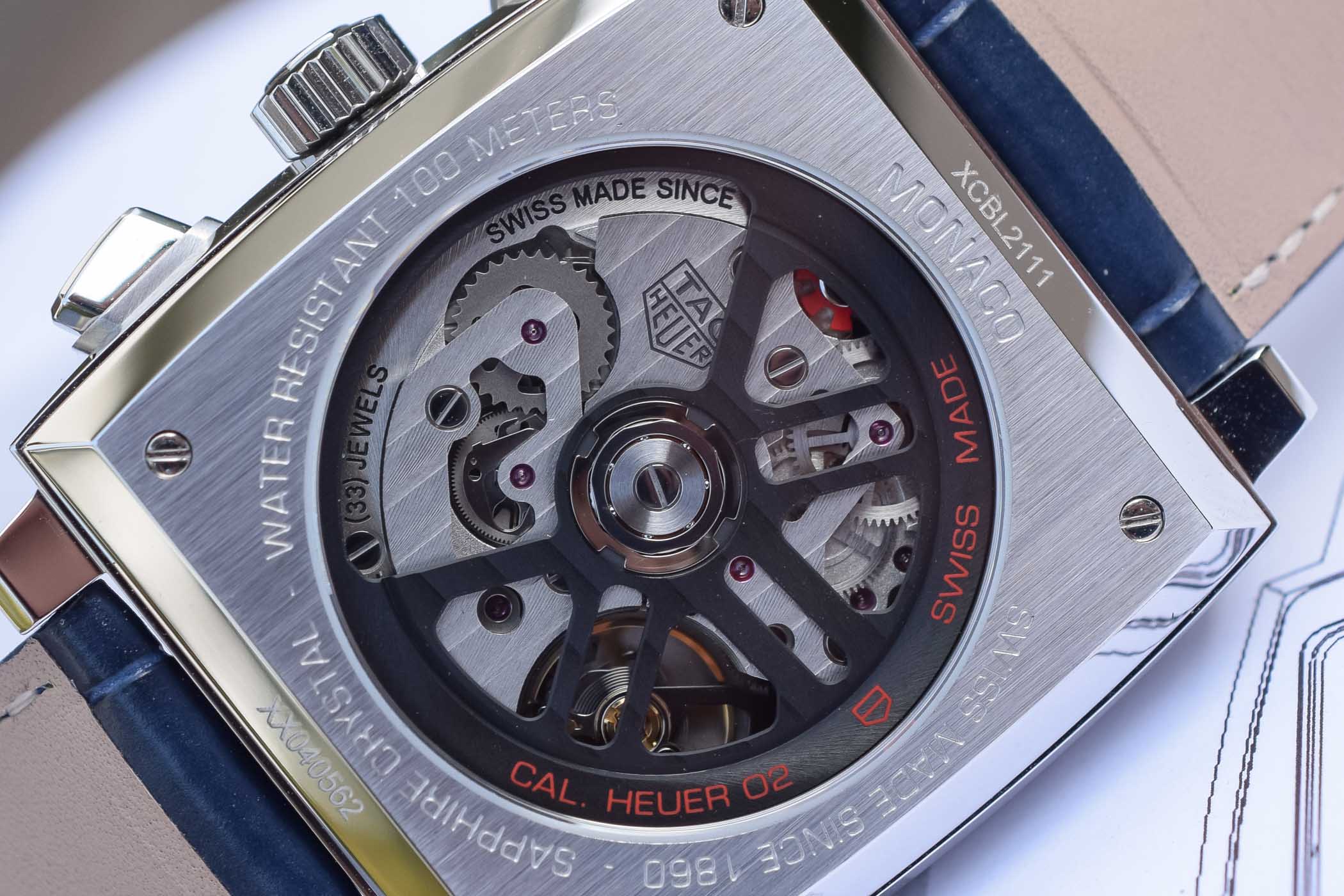
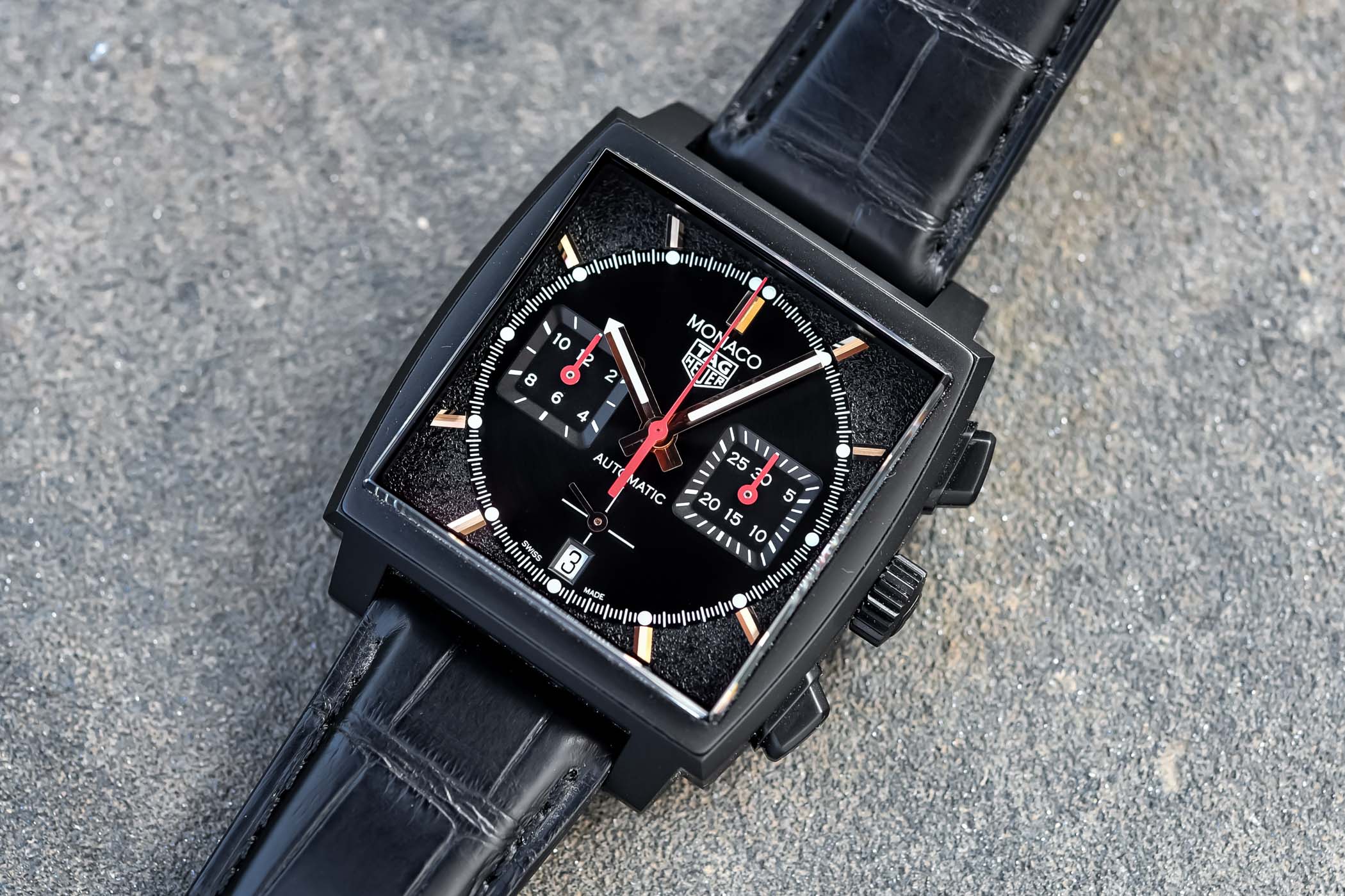


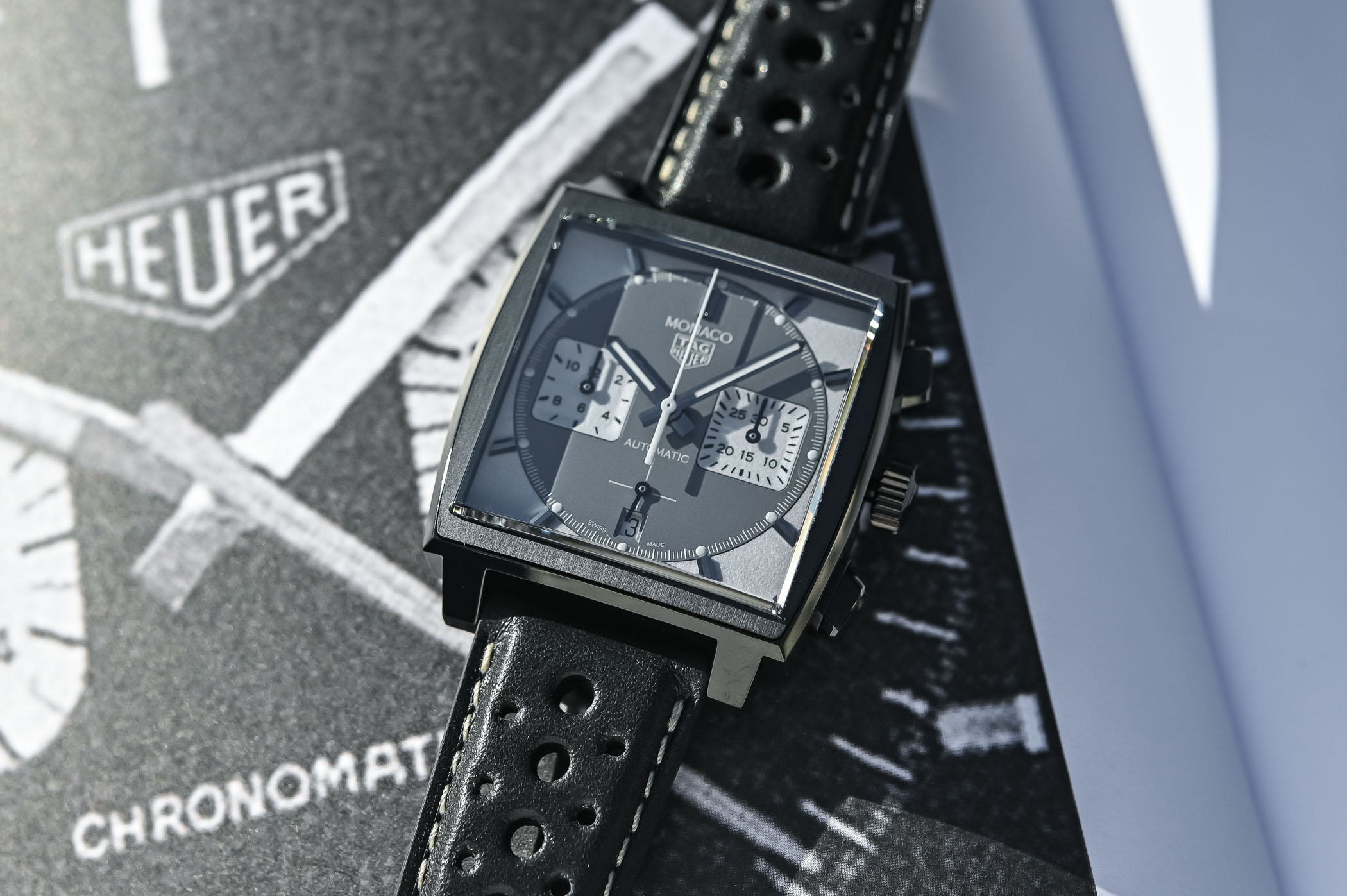
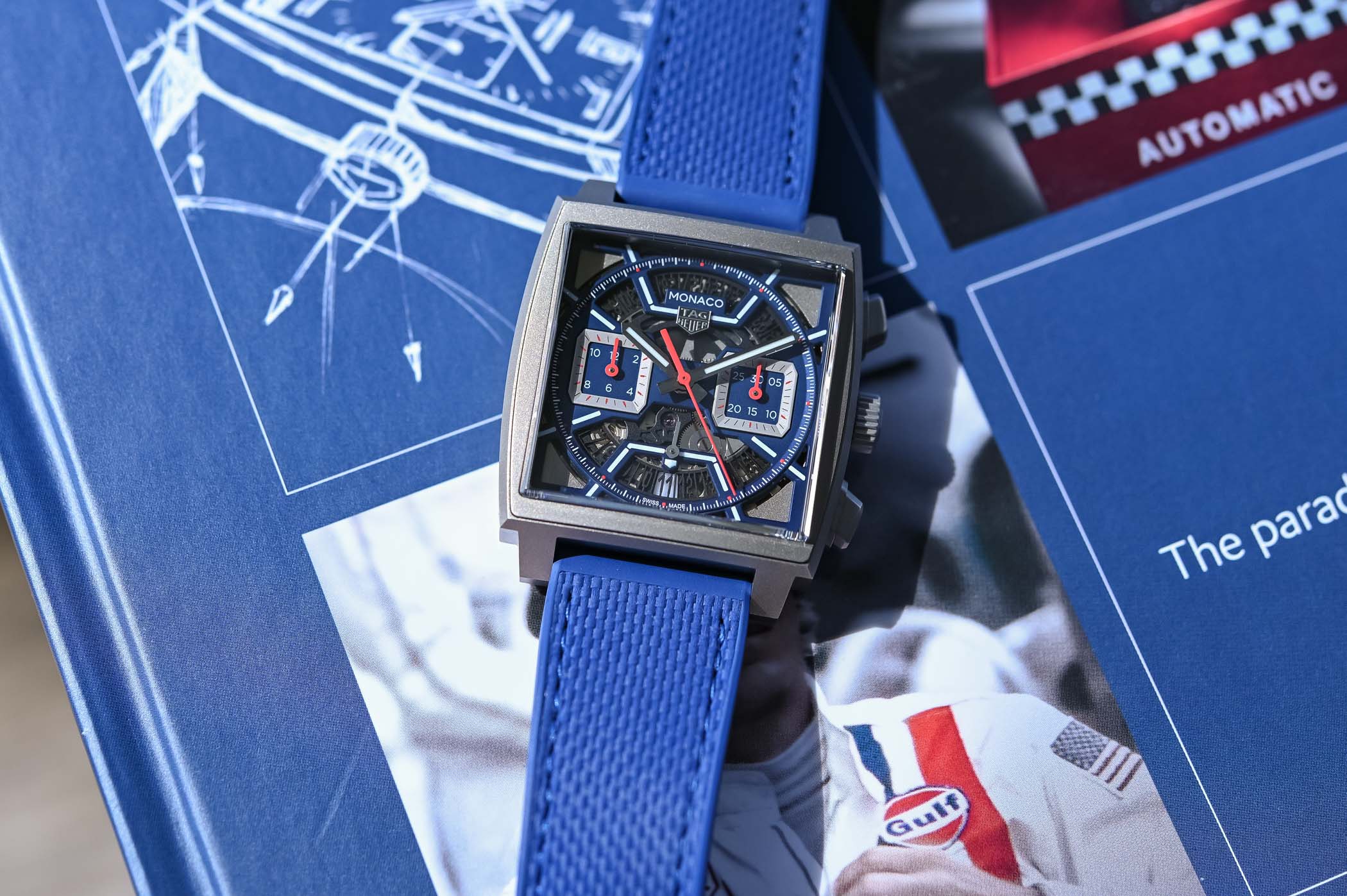








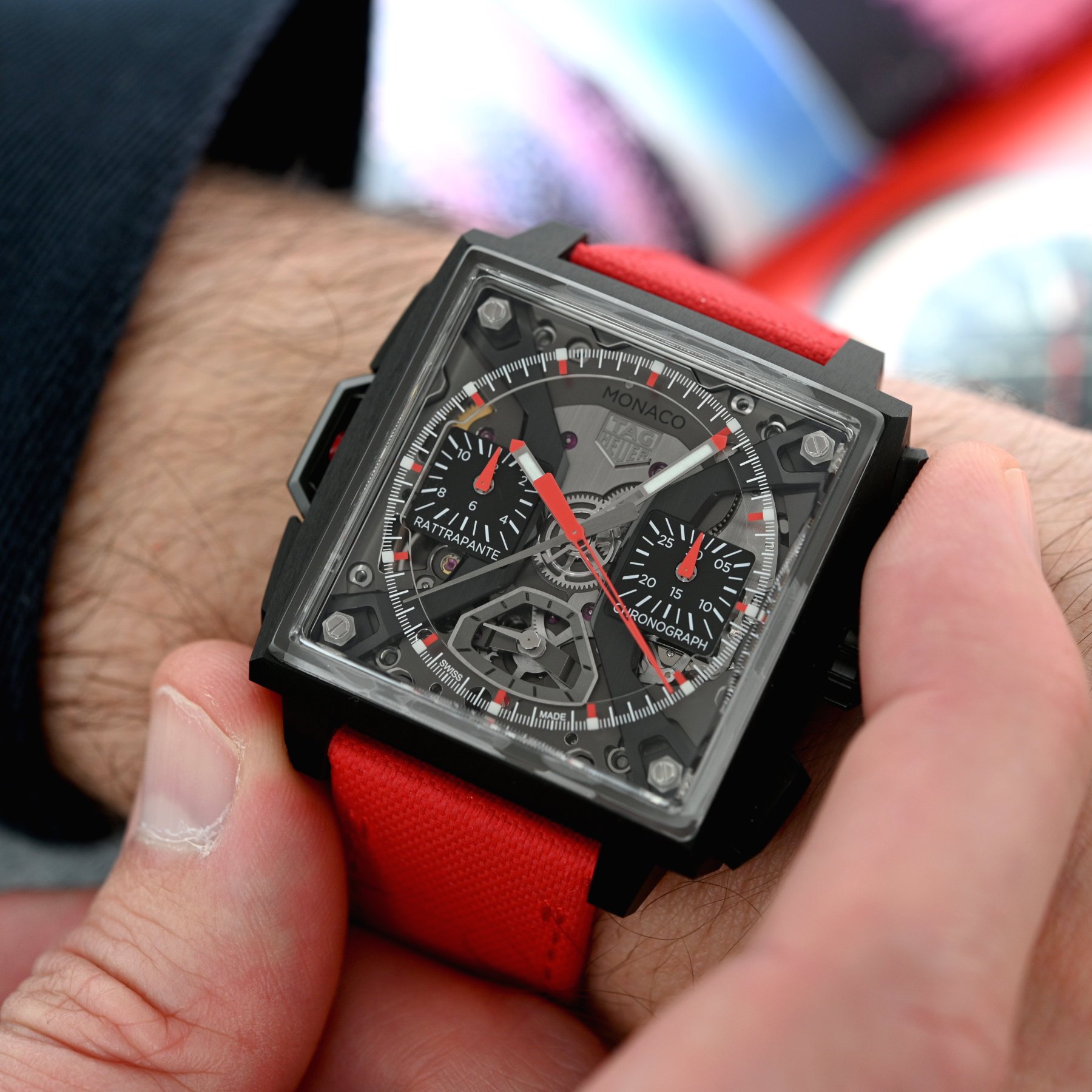

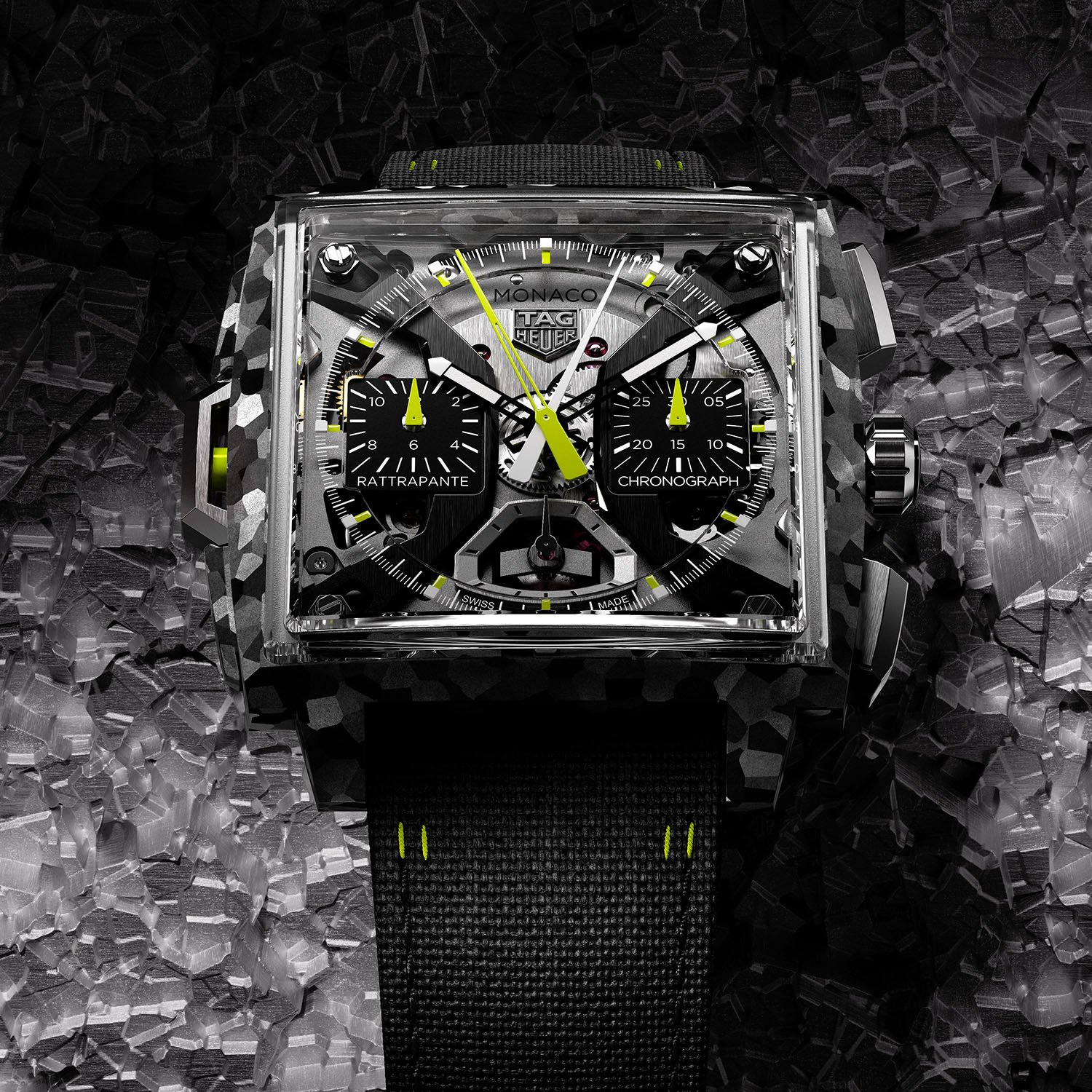

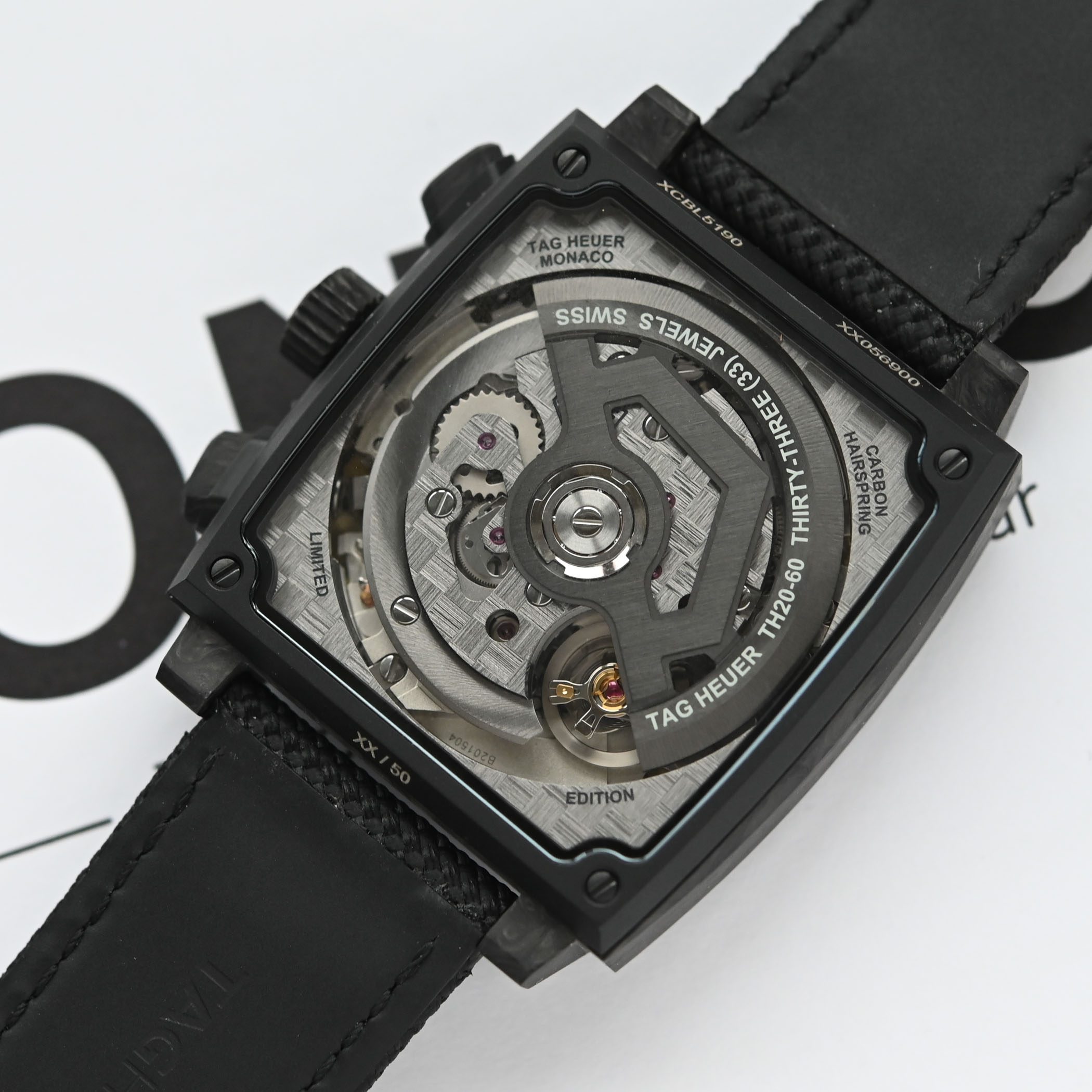


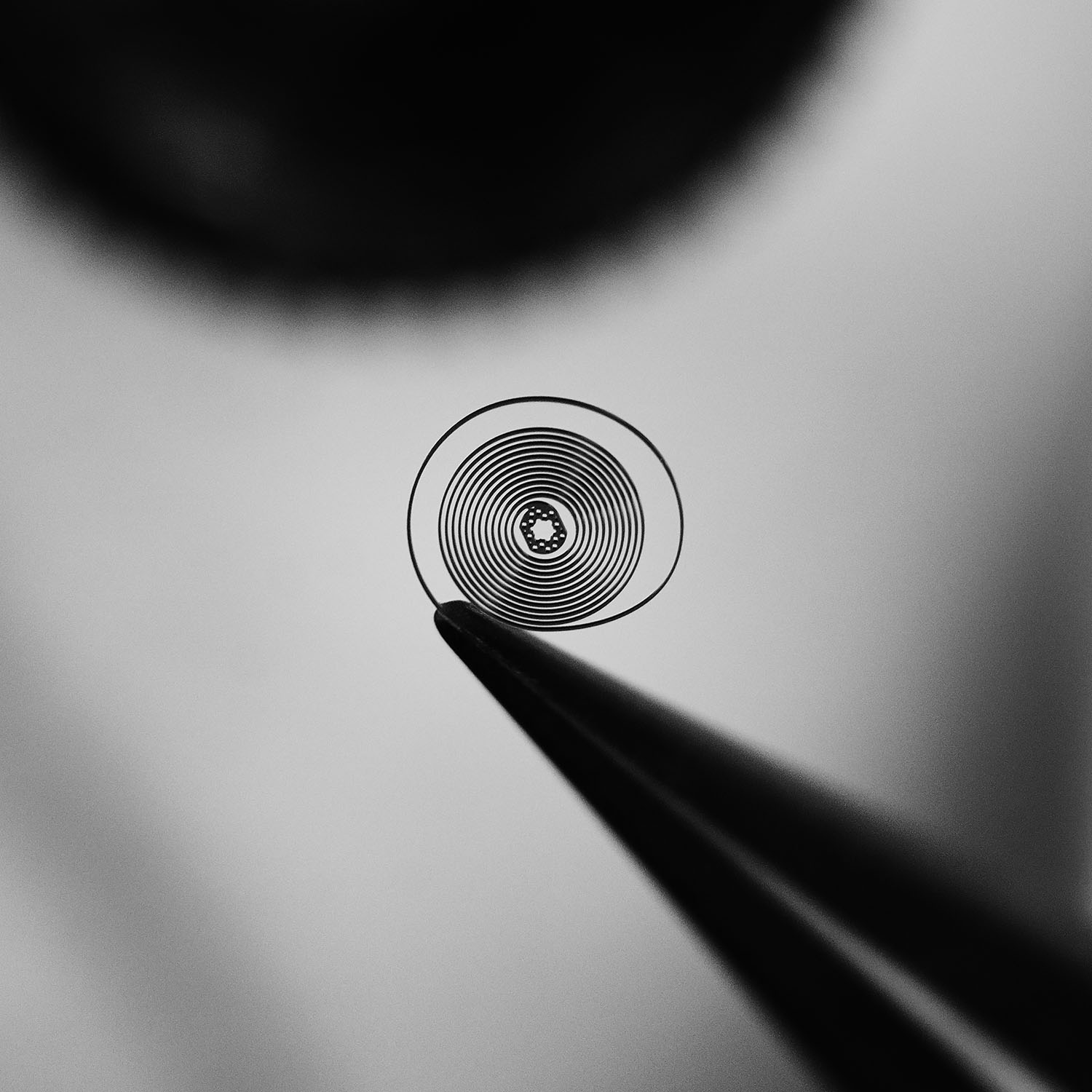
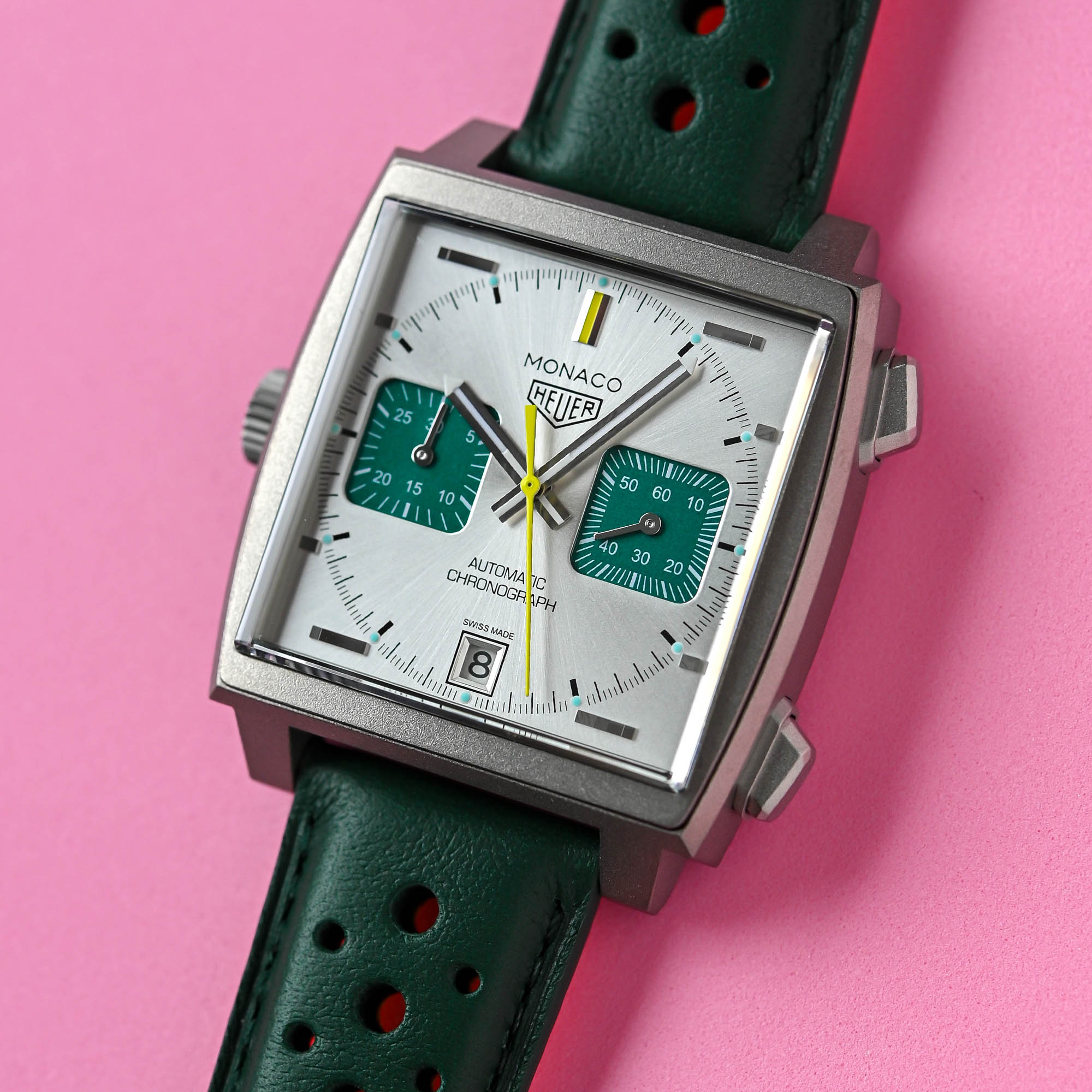
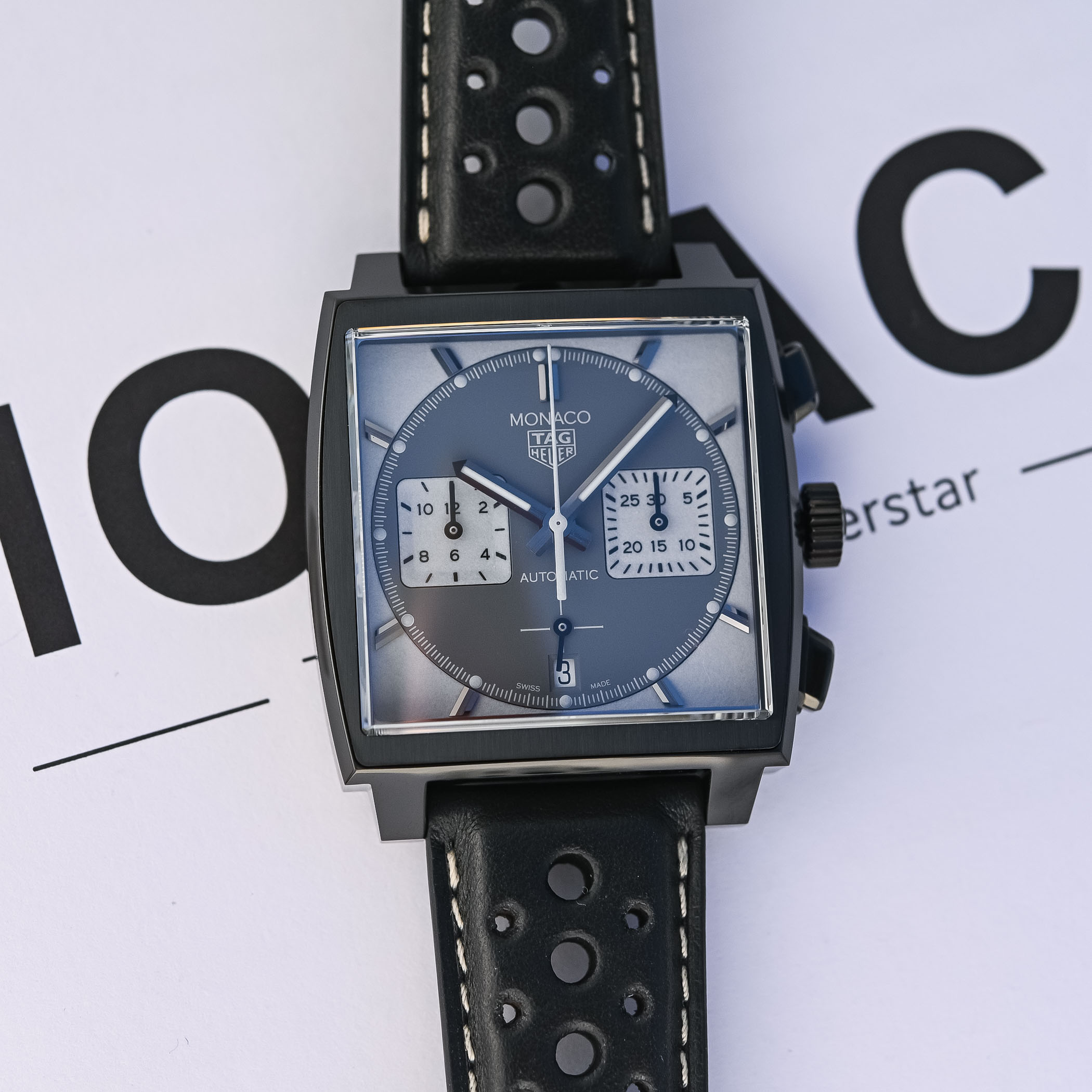



2 responses
A lot of information! This was a great article!!
Great article, where does the Monaco Twenty-Four Steve McQueen CAL5111.FC6299 edition fit in?
For me the combination of a circular inner clock face but physically separated from the square frame with a gap, is the most beautiful incarnation of a classic design!